We’re sorry, this site is currently experiencing technical difficulties. Please try again in a few moments. Exception: request blocked
- Election 2024
- Entertainment
- Newsletters
- Photography
- Personal Finance
- AP Investigations
- AP Buyline Personal Finance
- AP Buyline Shopping
- Press Releases
- Israel-Hamas War
- Russia-Ukraine War
- Global elections
- Asia Pacific
- Latin America
- Middle East
- Election Results
- Delegate Tracker
- AP & Elections
- Auto Racing
- 2024 Paris Olympic Games
- Movie reviews
- Book reviews
- Personal finance
- Financial Markets
- Business Highlights
- Financial wellness
- Artificial Intelligence
- Social Media

Yoon opens state visit with spotlight on space, mega deals
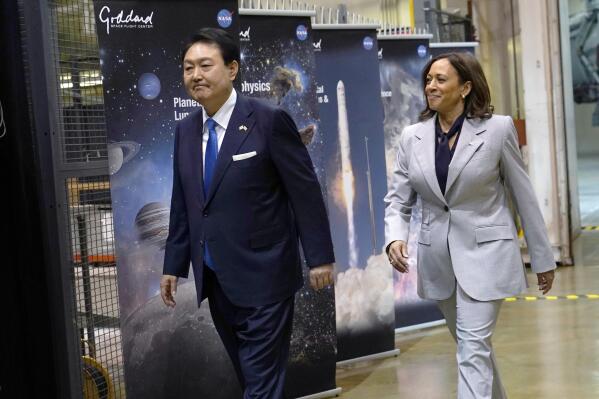
Vice President Kamala Harris, right, walks with South Korea’s President Yoon Suk Yeol, left, during a visit to NASA’s Goddard Space Flight Center in Greenbelt, Md., Tuesday, April 25, 2023. (AP Photo/Susan Walsh)
President Joe Biden and South Korea’s President Yoon Suk Yeol lay a wreath as they visit the Korean War Veterans Memorial in Washington, Tuesday, April 25, 2023. (AP Photo/Susan Walsh)
Vice President Kamala Harris and South Korea’s President Yoon Suk Yeol shake hands during a visit to NASA’s Goddard Space Flight Center in Greenbelt, Md., Tuesday, April 25, 2023. (AP Photo/Susan Walsh)
Vice President Kamala Harris, right, speaks as South Korea’s President Yoon Suk Yeol, left, listens during a visit to NASA’s Goddard Space Flight Center in Greenbelt, Md., Tuesday, April 25, 2023. (AP Photo/Susan Walsh)
President Joe Biden, first lady Jill Biden, South Korea’s President Yoon Suk Yeol and his wife Kim Keon Hee visit the Korean War Veterans Memorial in Washington, Tuesday, April 25, 2023. (AP Photo/Susan Walsh)
South Korea’s President Yoon Suk Yeol and his wife Kim Keon Hee talk with Judy Wade, the niece of Medal of Honor recipient Cpl. Luther Story, and her husband Joseph Wade, as they visit the Korean War Veterans Memorial in Washington, Tuesday, April 25, 2023. (AP Photo/Susan Walsh)
President Joe Biden, first lady Jill Biden, South Korea’s President Yoon Suk Yeol and his wife Kim Keon Hee talk with Judy Wade, the niece of Medal of Honor recipient Cpl. Luther Story, and her husband Joseph Wade, as they visit the Korean War Veterans Memorial in Washington, Tuesday, April 25, 2023. (AP Photo/Susan Walsh)
- Copy Link copied
WASHINGTON (AP) — South Korean President Yoon Suk Yeol opened his state visit to Washington on Tuesday by touring a NASA facility with Vice President Kamala Harris as the Biden administration looks to deepen ties with a close ally that it sees as only growing in importance in an increasingly complicated Indo-Pacific.
Before Harris and Yoon’s visit to the Goddard Space Flight Center in suburban Greenbelt, Md., the two countries signed a joint statement on cooperation in space communications and navigation, and received briefings from NASA scientists on cooperative efforts on space exploration and addressing the climate crisis,
“Our alliance is leading on some of the most important and pressing issues of our time,” Harris said in remarks with Yoon by her side at the NASA facility.
Yoon, for his part, recalled his exhilaration as a third-grader watching on television as Neil Armstrong and Buzz Aldrin stepped off Apollo 11 to become the first humans to set foot on the moon in 1969. Now, NASA and the Korea Aerospace Research Institute are working together to support future lunar exploration efforts searching for evidence of frost or ice deposits in permanently shadowed lunar regions.
Yoon said that the joint statement the two countries signed “will serve as a springboard for taking space cooperation between our two allies to the next level of a space alliance.”
“The universe holds great promise as the stage where synergies from international solidarity and partnerships can deliver their greatest benefits,” Yoon said.
Even before the formal itinerary for the Washington portion of Yoon’s six-day visit to the United States got under way, South Korean and U.S. companies unveiled a pair of whopper deals.
General Motors and South Korea’s Samsung SDI announced plans on Tuesday to build a $3 billion new electric vehicle battery cell plant in a yet-to-be determined location in United States. That came after Yoon on Monday met with a Netflix co-CEO Ted Sarando, who said the streaming platform would invest $2.5 billion in Korea on programming over the next four years, a reflection of the global appetite for Korean music, movies and television.
“We were able to make this decision because we have great confidence that the Korean creative industry will continue to tell great stories,” Sarando said. “We were also inspired by the president’s love and strong support for the Korean entertainment industry and fueling the Korean wave.”
Later Tuesday, Yoon and his wife, Kim Keon Hee, made an evening visit to the Korean War Memorial with President Joe Biden and first lady Jill Biden. They participated in a wreath-laying ceremony next to the memorial’s Pool of Remembrance.
Among other things, the Bidens presented their South Korean counterparts with a small handcrafted mahogany table inlaid with historical White House wood. It was topped with a vase filled with handmade paper hibiscuses and roses.
The visit comes just weeks after scores of highly classified documents were leaked that have complicated relations with allies, including South Korea. The papers viewed by The Associated Press indicate that South Korea’s National Security Council “grappled” with the U.S. in early March over an American request to provide artillery ammunition to Ukraine.
The documents, which cited a signals intelligence report, said then-NSC Director Kim Sung-han suggested the possibility of selling the 330,000 rounds of 155 mm munitions to Poland, since getting the ammunition to Ukraine quickly was the United States’ ultimate goal.
White House officials said that the leak wouldn’t cause lingering tensions but also declined say if the two leaders would discuss South Korea supplying Ukraine with the much-need ammunition.
“We have said many times we are engaging more broadly with our allies and partners that help at high levels to reassure them of our commitment to safeguarding intelligence and, and fidelity to our security, securing partnerships,” White House press secretary Karine Jean-Pierre said. She added that the U.S. commitment to South Korea is “ironclad.”
Biden and Yoon, along with their aides, will hold formal talks Wednesday at the White House and the two leaders will hold a joint news conference. In the evening, Biden will honor Yoon with a lavish state dinner.
The leaders’ private talks are expected to focus heavily on North Korea’s nuclear program and China’s military and economic assertiveness.
Biden, during the Yoon visit, is also expected to announce specific new nuclear deterrence efforts as well as a new cybersecurity initiative, economic investments and an educational partnership, part of an effort to highlight the breadth and depth of the two countries’ relationship as they mark the 70th anniversary of their alliance.
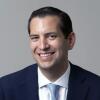
Mobile Menu Overlay
The White House 1600 Pennsylvania Ave NW Washington, DC 20500
Statement from White House Press Secretary Karine Jean-Pierre on the State Visit of President Yoon Suk Yeol and First Lady Kim Keon Hee of the Republic of Korea
President Joe Biden and First Lady Jill Biden will host President Yoon Suk Yeol and First Lady Kim Keon Hee of the Republic of Korea (ROK) for a State Visit to the United States, which will include a state dinner, on April 26, 2023. This will be the second State Visit of the Biden-Harris Administration. The upcoming visit celebrates the 70th anniversary of the U.S.-ROK alliance, which is critical to advancing peace, stability, and prosperity for our two countries, the Indo-Pacific, and around the world. President Biden and President Yoon will highlight the importance and enduring strength of the ironclad U.S.-ROK alliance as well as the United States’ unwavering commitment to the ROK. The Presidents will discuss our shared resolve to deepen and broaden our political, economic, security, and people-to-people ties.
Stay Connected
We'll be in touch with the latest information on how President Biden and his administration are working for the American people, as well as ways you can get involved and help our country build back better.
Opt in to send and receive text messages from President Biden.
South Korea's Yoon to visit US next week for summit with Biden
- Medium Text

Sign up here.
Reporting by Hyonhee Shin; Editing by Christian Schmollinger
Our Standards: The Thomson Reuters Trust Principles. New Tab , opens new tab
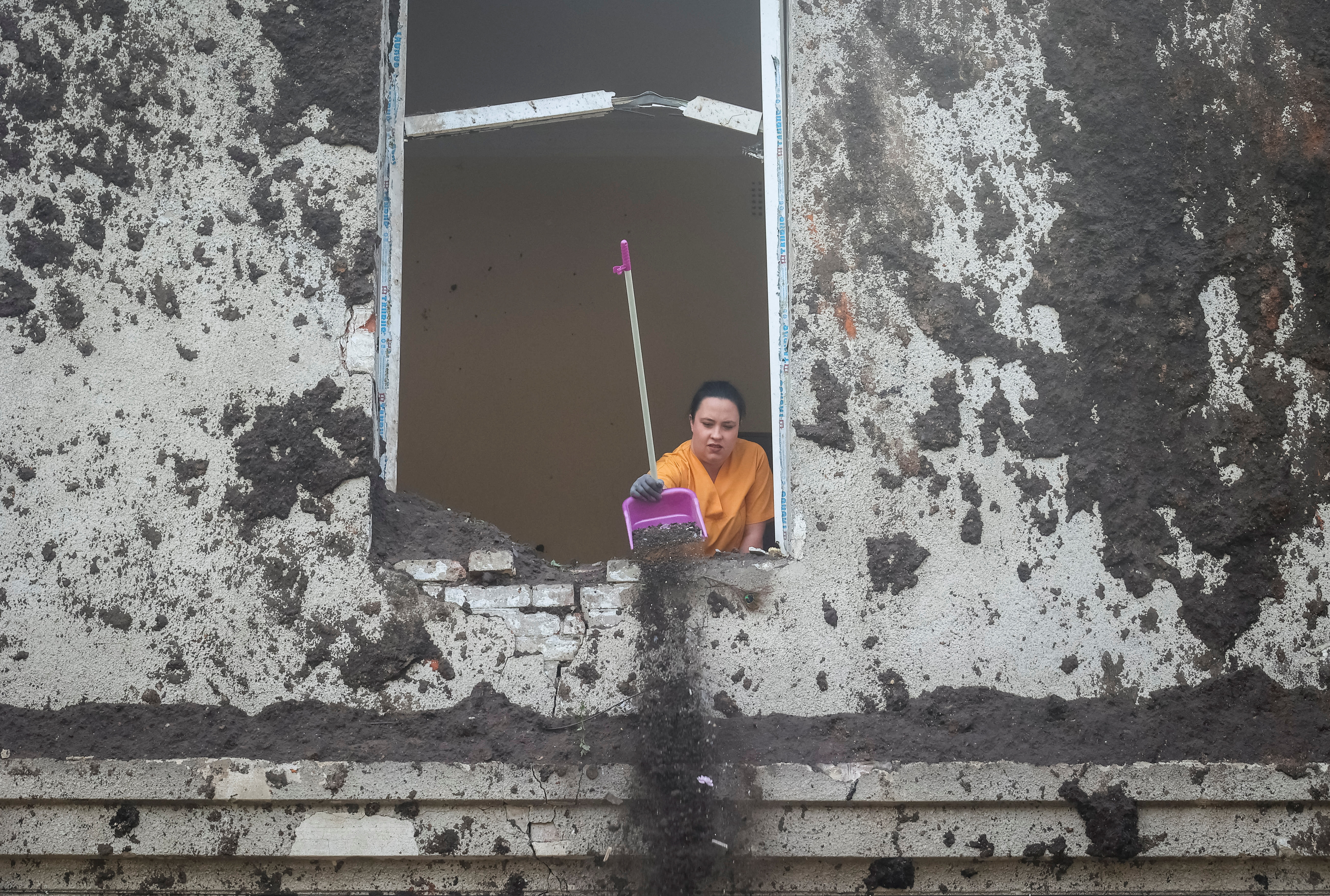
World Chevron
Russian missiles pound power plants in central and western ukraine.
Russian missiles pounded power facilities in central and western Ukraine on Saturday, increasing pressure on the ailing energy system as the country faces a shortage of air defences despite a breakthrough in U.S. military aid.
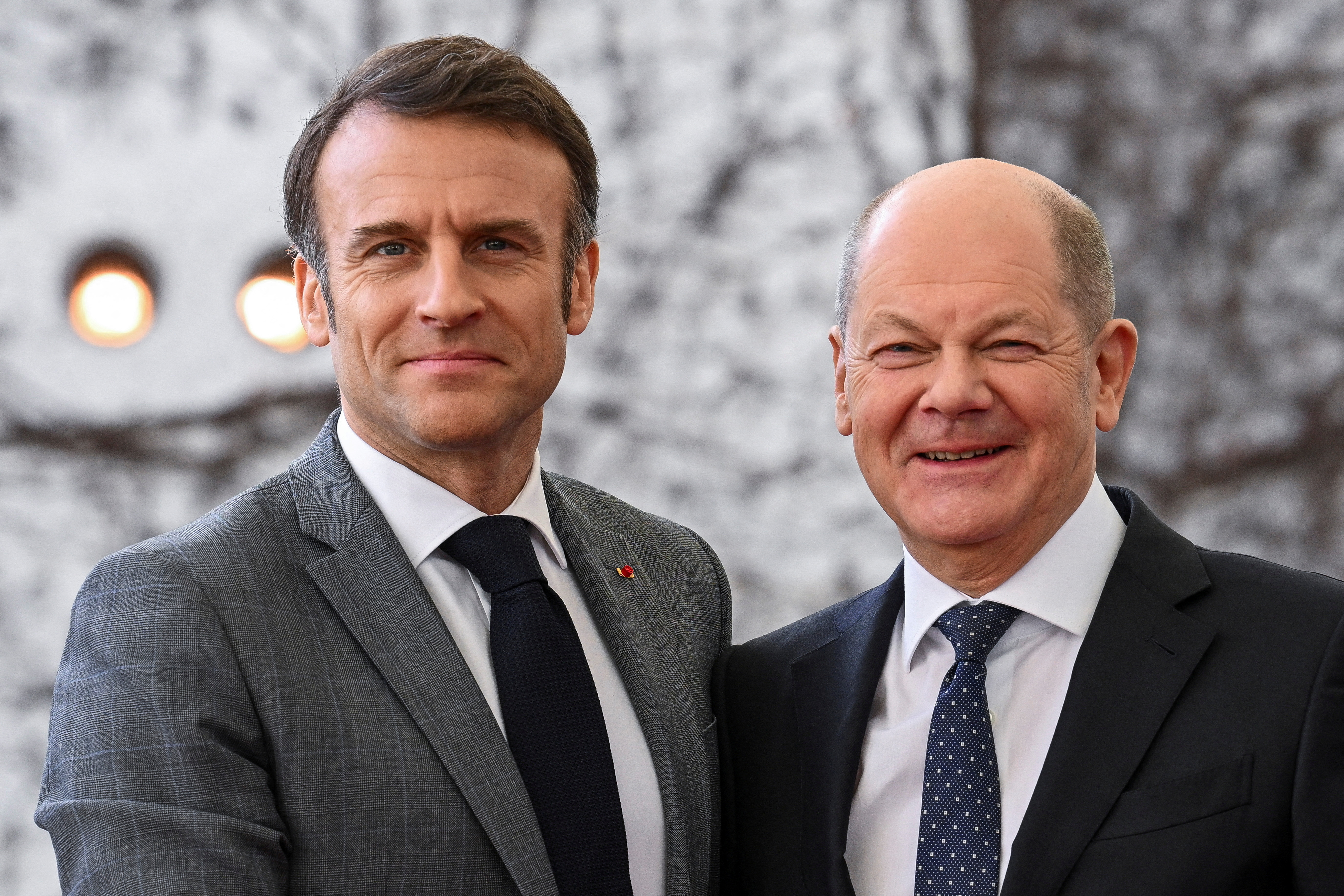
Programs submenu
Regions submenu, topics submenu, the future of the indo-pacific with the coast guard commandant, breaking bad: south korea's nuclear option, the future of u.s. lng exports: a conversation with rep. sean casten and rep. garret graves, strengthening u.s. critical minerals security: a fireside conversation with frank fannon.
- Abshire-Inamori Leadership Academy
- Aerospace Security Project
- Africa Program
- Americas Program
- Arleigh A. Burke Chair in Strategy
- Asia Maritime Transparency Initiative
- Asia Program
- Australia Chair
- Brzezinski Chair in Global Security and Geostrategy
- Brzezinski Institute on Geostrategy
- Chair in U.S.-India Policy Studies
- China Power Project
- Chinese Business and Economics
- Defending Democratic Institutions
- Defense-Industrial Initiatives Group
- Defense 360
- Defense Budget Analysis
- Diversity and Leadership in International Affairs Project
- Economics Program
- Emeritus Chair in Strategy
- Energy Security and Climate Change Program
- Europe, Russia, and Eurasia Program
- Freeman Chair in China Studies
- Futures Lab
- Geoeconomic Council of Advisers
- Global Food and Water Security Program
- Global Health Policy Center
- Hess Center for New Frontiers
- Human Rights Initiative
- Humanitarian Agenda
- Intelligence, National Security, and Technology Program
- International Security Program
- Japan Chair
- Kissinger Chair
- Korea Chair
- Langone Chair in American Leadership
- Middle East Program
- Missile Defense Project
- Project on Critical Minerals Security
- Project on Fragility and Mobility
- Project on Nuclear Issues
- Project on Prosperity and Development
- Project on Trade and Technology
- Renewing American Innovation Project
- Scholl Chair in International Business
- Smart Women, Smart Power
- Southeast Asia Program
- Stephenson Ocean Security Project
- Strategic Technologies Program
- Transnational Threats Project
- Wadhwani Center for AI and Advanced Technologies
- All Regions
- Australia, New Zealand & Pacific
- Middle East
- Russia and Eurasia
- American Innovation
- Civic Education
- Climate Change
- Cybersecurity
- Defense Budget and Acquisition
- Defense and Security
- Energy and Sustainability
- Food Security
- Gender and International Security
- Geopolitics
- Global Health
- Human Rights
- Humanitarian Assistance
- Intelligence
- International Development
- Maritime Issues and Oceans
- Missile Defense
- Nuclear Issues
- Transnational Threats
- Water Security
An Assessment of President Yoon’s State Visit to the White House

Photo: Chip Somodevilla/Getty Images
Critical Questions by Victor Cha
Published May 1, 2023
South Korean president Yoon Suk Yeol’s visit to the White House on April 26 was the fifth meeting with President Biden since their first summit held in Seoul in May 2022. The two leaders have built a good rapport through their continued engagement on the sidelines of the NATO Summit last summer, UN General Assembly in New York City this past fall, and the Association of Southeast Asian Nations (ASEAN) Summit in Phnom Penh last November.
Q1: What is the significance of Yoon being granted a state visit?
A1: A state visit is the highest honor bestowed by the White House on a visiting head of state. This was only the second such visit offered by the Biden administration (the other was to France) in large part because 2023 marks the 70th anniversary of the U.S.-Republic of Korea (ROK) alliance. The Biden administration also wishes to show strong support for Yoon’s foreign policy agenda which has shifted to deepening strategic ties with the United States and away from the hedging strategy of the previous administration.
Q2: What was the biggest takeaway from the summit?
A2: Aside from setting a high bar for musical performances by future world leaders at the White House, the main deliverable of the summit was the Washington Declaration . The declaration is the closest the alliance has come to a shared decisionmaking framework for the use of nuclear weapons in Korea, and effectively has committed the two allies to a nuclear planning group in the establishment of the Nuclear Consultation Group (NCG). NCG activities will include joint nuclear planning and execution concerning U.S. nuclear operations in a contingency, as well as exercising with U.S. Strategic Command. The United States also will maintain a regular rotation of air- and sea-based nuclear capable assets, starting with a nuclear ballistic missile submarine to South Korea for the first time since 1981. While this is not tantamount to the return of tactical nuclear weapons to the peninsula (as advocated by some), it does represent a presence of nuclear capable assets around the peninsula for deterrence and assurance purposes. The declaration is a significant document that sharpens the meaning and execution of the U.S. nuclear guarantee and will sit alongside the 1953 Mutual Defense Treaty. While this was not part of the declaration, the two sides also agreed in to education and training on nuclear deterrence for ROK military personnel.
Nevertheless, like most major documents or statements, the Washington Declaration has met some criticism in South Korea both from progressives and conservatives. The progressive opposition party has denounced the summit outcomes for warmongering and some from the conservative camp have criticized Yoon’s reaffirmation of South Korea’s nonnuclear status and compliance with the Non-Proliferation Treaty (NPT) during the summit. Neither criticism really holds water. Rather than warmongering, the Washington Declaration tries to address South Korean concerns that nuclear deterrence may not be strong enough to prevent North Korea from disturbing the peace. Yoon's statement on the NPT is simply a reiteration of existing South Korea policy, and is a responsible statement given all the loose talk and polling lately regarding nuclear weapons in South Korea. To have expected him to disavow the NPT during the summit would have been absurd.
Q3: Besides North Korea and extended deterrence, were there other noteworthy deliverables for the alliance?
A3: Yes, a lot. The two leaders used the 70th anniversary of the alliance to highlight and build the so-called New Frontiers agenda of the relationship. First, Biden and Yoon both featured the global nature of the alliance providing not just private goods to each party but also public goods for the world. Biden supported Yoon’s new global agenda, including hosting the next Democracy Summit, partnering with NATO (as member of NATO Asia-Pacific partners), and partnering with the G7. Yoon made about the boldest statements for an Asian leader on Ukraine, featured at the top of the joint statement, condemning Russia for war and for attacks against civilians and civilian infrastructure. The reference to attacks on civilians lines up with previous conditions Yoon has laid out for sending lethal equipment to Ukraine. Yoon has little room to maneuver under the current law, but his inclinations on this issue are clear as evidenced in this document and in his speech before a joint session of Congress.
Second, the two leaders used the summit to make significant progress on several New Frontier issues. There was a new joint statement on U.S.-ROK cooperation in quantum information science and technology and a new high-level Next Generation Critical and Emerging Technologies Dialogue (led by national security advisers). The two sides also agreed to establish a U.S.-ROK Strategic Cybersecurity Cooperation Framework. And it appears as though some streamlining of export controls policies will allow for more collaboration in space, that will facilitate more commercial and governmental cooperation in space. The two sides also affirmed continued cooperation on artificial intelligence (AI), biotechnology, medical products using AI, and biomanufacturing.
Q4: What are the takeaways on North Korean denuclearization and trilateral relations with the United States, Korea, and Japan?
A4: Biden and Yoon reiterated their commitment to diplomacy and denuclearization of North Korea, which was expected. The two put more emphasis, however, on human rights abuses in North Korea and also made explicit reference to aspirations for Korean unification in the joint statement, which was not seen in U.S. joint statements with the previous government.
On Japan, Biden made reference to Yoon’s “political courage” and leadership to take the initiative to improve South Korea's relations with Japan. This has become a regular adulation by White House officials regarding Yoon’s efforts with Japan. Behind the scenes, White House officials have expressed some frustration with the tepid response from Tokyo on the forced labor compensation deal and hope that Kishida will use an upcoming visit to South Korea in early May to do more. Biden and Yoon also made reference to economic security dialogues bilaterally and trilaterally with Japan. The latter suggests U.S. acceptance of a Yoon-proposed 2+2+2 on economic security.
Q5: How will China react to the U.S.-ROK summit?
A5: China will respond negatively to the summit. Yoon agreed to regularize anti-submarine and missile defense exercises, information-sharing, interdiction, anti-piracy, and also the Humanitarian Assistance and Disaster Relief (HADR) trilateral exercises with the United States and Japan. The commitment to missile defense exercises, China would say, is a violation of the “three no’s” agreement of the previous administration. The United States and South Korea also made a very strong (and new) statement on opposing economic coercion which clearly refers to China (though unnamed). South Korea also agreed to a new and strong statement on opposing any changes to the status quo in the Taiwan Straits through use of force, as well as “unlawful maritime claims, the militarization of reclaimed features, and coercive activities” in the South China Sea. All of these are new major statements that will surely anger China, as they demonstrate a clear shift by South Korea to the United States and away from the previous hedging strategy.
Q6: Were there any big deliverables on economic/trade issues?
A6: The Biden administration’s acknowledgment of the intent to work closely with the Yoon government on the Inflation Reduction Act (IRA), CHIPS and Science Act, and export controls suggests that going forward, there might be more consultation with Korea and other key partners on rule-making rather than unilateral disclosures. Yet there was no sense that any new measures had been offered at this summit. However, it is noteworthy that U.S. companies have announced about $5.9 billion investments into South Korea, including from Netflix and Corning.
On climate change, both sides reiterated their Nationally Determined Contributions under the Paris Agreement. They also remained committed to nuclear energy cooperation, but no apparent resolution was reached on the legal dispute between Westinghouse and KEPCO, which will hold up any further collaboration.
Victor Cha is senior vice president for Asia and Korea Chair at the Center for Strategic and International Studies (CSIS) in Washington, D.C.
Critical Questions is produced by the Center for Strategic and International Studies (CSIS), a private, tax-exempt institution focusing on international public policy issues. Its research is nonpartisan and nonproprietary. CSIS does not take specific policy positions. Accordingly, all views, positions, and conclusions expressed in this publication should be understood to be solely those of the author(s).
© 2024 by the Center for Strategic and International Studies. All rights reserved.

Programs & Projects
실시간 주요 뉴스 PUSH 알림서비스를 구독할 수 있습니다.

korea joongAng daily
Home > national > diplomacy.

Yoon's state visit a 'crowning moment' in thriving Korea-U.K. ties
![yoon state visit Britain's King Charles III, second from left, is greeted by the Korean community in front of New Malden Methodist Church in England on Nov. 8, in a trip to London’s Koreatown ahead of President Yoon Suk Yeol’s state visit this week. [AP/YONHAP]](https://koreajoongangdaily.joins.com/data/photo/2023/11/22/bcdcd2b6-0f5c-4ce7-96fb-bcf88656ec61.jpg)
Britain's King Charles III, second from left, is greeted by the Korean community in front of New Malden Methodist Church in England on Nov. 8, in a trip to London’s Koreatown ahead of President Yoon Suk Yeol’s state visit this week. [AP/YONHAP]
![yoon state visit British Ambassador to South Korea Colin Crooks speaks in an interview with the Korea JoongAng Daily at the diplomatic residence in central Seoul earlier this year. [PARK SANG-MOON]](https://koreajoongangdaily.joins.com/data/photo/2023/11/22/ad514064-30bf-4e00-a4a6-c3a192a6b41e.jpg)
British Ambassador to South Korea Colin Crooks speaks in an interview with the Korea JoongAng Daily at the diplomatic residence in central Seoul earlier this year. [PARK SANG-MOON]
![yoon state visit Korean President Yoon Suk Yeol, right, shakes hands with King Charles III at a reception at Buckingham Palace in London on Sept. 18, 2022, ahead of the state funeral for Queen Elizabeth II. [YONHAP]](https://koreajoongangdaily.joins.com/data/photo/2023/11/22/225d4260-5f34-491b-8b19-10ec9011580b.jpg)
Korean President Yoon Suk Yeol, right, shakes hands with King Charles III at a reception at Buckingham Palace in London on Sept. 18, 2022, ahead of the state funeral for Queen Elizabeth II. [YONHAP]
![yoon state visit Korean President Yoon Suk Yeol, left, and British Prime Minister Rishi Sunak shake hands during their bilateral summit at the G7 gathering in Hiroshima, Japan, on May 20. [PRESIDENTIAL OFFICE]](https://koreajoongangdaily.joins.com/data/photo/2023/11/22/f9767d03-f686-4aff-834d-cd73f5a2d248.jpg)
Korean President Yoon Suk Yeol, left, and British Prime Minister Rishi Sunak shake hands during their bilateral summit at the G7 gathering in Hiroshima, Japan, on May 20. [PRESIDENTIAL OFFICE]
![yoon state visit Hyundai Motor Group Chair Euisun Chung, right, receives the Commander of the Most Excellent Order of the British Empire presented by British Ambassador to Korea Colin Crooks on Tuesday at the embassy in central Seoul. [HYUNDAI MOTOR GROUP]](https://koreajoongangdaily.joins.com/data/photo/2023/11/22/ef12c7eb-7b4e-4da5-98f9-86bd8cad1b9c.jpg)
Hyundai Motor Group Chair Euisun Chung, right, receives the Commander of the Most Excellent Order of the British Empire presented by British Ambassador to Korea Colin Crooks on Tuesday at the embassy in central Seoul. [HYUNDAI MOTOR GROUP]

More in Diplomacy
U.S. deputy secretary of state says Yoon and Kishida deserve Nobel Peace Prize
Nicaragua to close embassy in Korea again 10 years after first closure
Korea, Romania agree to strengthen strategic partnership at summit
Foreign minister focuses on geopolitical crises at gathering of mission heads in Seoul
Israel to summon UN envoys to protest Palestine membership vote
Related Stories
Korea, U.K. to sign 'Downing Street' accord establishing 'global strategic partnership'
King Charles gives nod to Blackpink, calls BTS Korea’s ‘Beatles’ in state banquet
Korea, Britain sign 'Downing Street Accord’ to raise ties to highest level
Yoon begins Vietnam visit by promoting industries, K-food
Yoon Suk Yeol's visit to Japan this month under strong consideration
You might also like

To write comments, please log in to one of the accounts.
Standards Board Policy (0/250자)

Biden, South Korea to increase signs of military power as show of force against North Korea
WASHINGTON – President Joe Biden announced Wednesday that he is increasing demonstrations of military might in the Indo-Pacific and expanding collaboration with South Korea in hopes of deterring an attack by North Korea.
In exchange, South Korean President Yoon Suk Yeol reaffirmed his nation's commitment not to develop its own nuclear weapons.
Biden and Yoon delivered the joint statement after a bilateral meeting at the White House. It's the centerpiece of the new initiatives on cybersecurity, economic investments and more that the leaders are rolling out during Yoon's state visit marking the 70th anniversary of the alliance between the two nations.
"Our nuclear defense treaty is ironclad," Biden said, standing next to the South Korean leader on the White House South Lawn. "And that includes our commitment to extended deterrence."
The two leaders took a few steps from their podiums to shake hands as Biden thanked Yoon for his "friendship and partnership."
Prep for the polls: See who is running for president and compare where they stand on key issues in our Voter Guide
Earlier in the day, Biden greeted Yoon and Kim Keon Hee, first lady of the Republic of Korea, during an arrival ceremony Wednesday morning that honored Korean War veterans as military bands played the anthems of both nations.
Yoon, speaking through an English translator, said the U.S.-South Korean alliance is "not a transactional relationship" based on self-interests but "an alliance of values, standing together to safeguard the universal value of freedom."
Stay in the conversation on politics: Sign up for the OnPolitics newsletter
'Let's finish the job': President Joe Biden announces much awaited 2024 reelection bid
South Korea benefits from the protection of the U.S. “nuclear umbrella,” the main deterrent against attacks from North Korea.
Biden said a nuclear attack by North Korea against the United States or its partners would "result in the end of whatever regime, were it to take such an action."
But North Korea’s aggressive missile testing and lack of interest in denuclearization talks has raised concerns in South Korea that more needs to be done.
The creation of a joint consultation group is intended to increase the confidence in the U.S. of not just Seoul but also the South Korean people. The South Korean government will be given more insight into U.S. military planning and a voice in those deliberations, according to a senior administration official.
Biden made clear that as commander-in-chief he has “absolute” and “sole authority” to use a nuclear weapon. “What the declaration means is that we're going to make every effort to consult with our allies, when it's appropriate, if any actions so call for it,” he said.
The U.S. will also increase public demonstrations of strength, such as sending a ballistic missile submarine on visits to South Korea for the first time since the 1980s.
“This is a new level of extended deterrence, much stronger,” Yoon said through an interpreter.
Yoon took office last year after a closely contested election in which he vowed to bolster South Korea's defenses against North Korea.
- Second state visit: This is only the second state visit Biden has hosted. The first was last fall’s summit with French President Emmanuel Macron. The last state visit with South Korea was hosted by President Barack Obama in 2011.
- Gifts exchanged: Biden and first lady Jill Biden gave Yoon a small, handcrafted mahogany table made of historical White House wood by a U.S. furniture maker and inspired by traditional Korean soban tables. The president also presented Yoon with a shadow box set with custom and vintage baseball memorabilia, while Jill Biden presented Kim with a pendant necklace with blue sapphires designed by a Korean American designer.
- Why now: The two nations are marking the 70th anniversary of their alliance. In addition, the U.S. has been trying to strengthen its relationships in Asia as a counterbalance to China’s increasing economic and military might. During his visit to South Korea last May, Biden said “revitalizing” the alliance between the nations was one of his “key foreign policy priorities.”
- The schedule: In addition to their private meetings Wednesday, Biden and Yoon will attend a state dinner, a diplomatic honor reserved for the U.S.’s closest allies. Yoon will address a joint House and Senate meeting Thursday. While he’s in the U.S., Yoon also has trips to NASA, the Massachusetts Institute of Technology, Harvard University and is meeting with the CEOs of entertainment companies like Disney, Netflix and Sony Pictures.
- Economic collaboration and conflict: The Biden administration has touted South Korea’s billions of dollars in economic investments in the U.S., including in electric vehicle manufacturing, one of the ways the administration wants to strengthen supply chains while creating jobs. But South Korea is concerned how U.S. restrictions on technology exports to China will affect South Korean companies that make semiconductors there.
Pentagon leak complicates state visit
The state visit was complicated by the leak of classified documents that included evidence the U.S. has been spying on allies. It was an embarrassment for the Biden administration and caused Yoon political headaches back home, making it more important that Yoon be able to show he’s getting something from the summit. That could include announcements on expanded economic cooperation or more efforts to deter North Korea’s belligerence.
'Embarrassing wrench': How Pentagon leak complicates South Korean president's state visit with Biden
Ukraine likely to be discussed
Leaked intelligence indicates top advisers to Yoon were concerned ammunition South Korea agreed to sell the U.S. to refill its stockpiles would wind up in Ukraine. South Korea does not send lethal weapons to countries at war, but the trove of documents – which U.S. officials have neither verified nor disavowed – suggested that Yoon's government was considering a policy shift.
Yoon told Reuters last week it would be difficult for South Korea to stay on the sidelines of Russia’s invasion of Ukraine “if there is a situation the international community cannot condone, such as any large-scale attack on civilians, massacre or serious violation of the laws of war."
It’s too early to tell if South Korea is ready to amp up support beyond humanitarian assistance, said Ellen Kim, an expert on U.S.-Korea relations at the Center for Strategic and International Studies. But given the increased cooperation between Russia and North Korea, South Korea finds it “increasingly difficult to avoid entrapment in Ukraine,” Kim said.
clock This article was published more than 1 year ago
At the state dinner for South Korea, two nations toast an anniversary
Irish sentiments, warmed-over warnings to north korea and a little angelina jolie at wednesday’s white house gathering for a “deep friendship”.
The state dinner for South Korea ended Wednesday without bad gaffes or good quotes, leaving only sparkling chardonnay and flat bromides, with a dash of Angelina Jolie and a diplomatic amuse-bouche: a joint declaration from President Biden and President Yoon Suk Yeol that served the usual warmed-over warnings to North Korea.
But first, the toasts: delivered to nearly 200 guests in the East Room of the White House, where soaring glass centerpieces on aquamarine tablecloths created a pink canopy of cherry blossoms.
“Our alliance was born out of not shared borders but need,” said Biden, in his 49th year in elected office, and on day two of his campaign to ask for four more. “Shared beliefs: a belief in democracy, liberty, security and, above all, a mutual belief in freedom.”
Yoon, a 62-year-old career prosecutor who first entered electoral politics 22 months ago, knew exactly how to tickle Biden. “Mr. President, allow me to quote an Irish poet of yours,” he said through an interpreter, as Biden laughed and patted him on the back. “Seamus Heaney once wrote: 'Behavior that’s admired is the path to power among people everywhere.’”
The second state dinner of the Biden presidency was the social climax of Yoon’s six-day visit to the states, timed to mark the 70th anniversary of the mutual defense treaty between South Korea and the United States. Biden and Yoon have previously advertised the alliance as the “linchpin” for peace and prosperity in a region crowded with tensions and adversaries. On Wednesday morning, after welcoming Yoon to the White House, Biden added more descriptors: “ironclad alliance,” “deep friendship” and “unbreakable bond.”
The dinner bisected a busy week in political pageantry: debt-ceiling flimflam in Congress, the Murdoch family’s defenestration of Fox News anchor Tucker Carlson, a woman in a Manhattan courtroom accusing Donald Trump of rape, the fast approaching (and broadly dreaded) White House correspondents dinner on Saturday. The South Korean president’s official visit was calm and collected by comparison, despite journalists’ attempts to shake loose a good quote — about economic pressure on China that may inadvertently hurt South Korea, about North Korea’s steps toward possibly conducting another nuclear-detonation test, about Biden’s age as he runs for reelection.
“The reason I’m running again is there’s a job to finish,” Biden said during a joint news conference with Yoon in the Rose Garden.
On Tuesday afternoon Yoon, alongside Vice President Harris, talked about Carl Sagan’s “Pale Blue Dot” at NASA’s Goddard Space Flight Center in Maryland. That evening, minutes before sunset, the first couples paid their respects at the Korean War Memorial as a bugler played taps. On Wednesday morning, as their husbands had closed-door meetings about space and cyber and climate issues, Jill Biden and South Korean first lady Kim Keon Hee visited the Rothkos at the National Gallery of Art. Both women are fans of the artist.
At the state dinner, Jill Biden stays understated
The state dinner had the pleasing, comfortable vibe of an anniversary dinner for a couple who had been together for nearly a lifetime — which is true, in the case of South Korea and the United States. The nations first signed a treaty when Biden was a 10-year-old moving from Scranton, Pa., to Delaware.
The guest list was heavy on corporate and bureaucratic figures: the CEO of Korean Air, for example, and the mayor of Wilmington, Del. Higher-profile attendees included Olympic snowboarder Chloe Kim, whose parents are from South Korea; home-renovation power couple Chip and Joanna Gaines (her mother is from South Korea); the first three Korean American women elected to Congress (Democrat Marilyn Strickland of Washington state and Republicans Young Kim and Michelle Steel of California); the secretaries of defense, state and commerce; the governors of Kentucky, New Jersey and Vermont; Broadway performers Norm Lewis, Lea Salonga and Jessica Vosk, who were scheduled to sing after dinner; and eternal superstar Jolie and her son Maddox Jolie-Pitt, 22, a student at Yonsei University in Seoul.
His favorite thing about Seoul?
“The people,” Jolie-Pitt said, as his mother swept him past journalists in a blur of ivory chiffon.
Do the Gaineses have any design tips for the White House?
“Oh gosh no,” Joanna said.
“White interiors and exteriors is just her thing,” Chip said.
Kim was asked if she considered adorning her gown with Olympic gold.
“I didn’t wear my medal,” she said. “I don’t know where it is.”
State dinner guests include Angelina Jolie, Chip and Joanna Gaines
During the cocktail reception, guests dabbed their lips with linens colored platinum, in honor of the 70-year partnership. The East Room decor invoked taegeuk, the red-and-blue symbol of balance and harmony at the center of the Korean flag. Guests sat on aquamarine seat covers featuring renderings of bamboo and peonies, a favorite flower of the first lady of South Korea, in the style of sumukhwa (Korean ink brush painting).
The first course was Maryland crab cake, with a gochujang vinaigrette (from a chili paste popular in Korea) and a kimchi-esque slaw of cabbage, kohlrabi, fennel and cucumber, accompanied by chilled yellow squash soup with cured strawberries in a gold-handled cup from the George W. Bush service china.
The main course was braised beef short ribs nestled on butter bean grits, topped with sorghum-glazed carrots and pine nuts, and garnished with pink dianthus and sea-thrift petals from the White House garden.
Dessert was lemon bar ice cream encircled by fresh berries and bananas caramelized with doenjang (fermented soybeans), and dusted with mint gingersnap cookie crumble.
“I wanted to showcase the best of American cuisine merged with a touch of Korean flavors,” said guest chef Edward Lee, of Louisville, whose mother immigrated from South Korea.
Biden's South Korea state dinner menu features fusion — and ice cream
The last time a U.S. president threw a state dinner for South Korea was in the autumn of 2011, when Biden was second-in-command. Since then, South Korean culture has ballooned in popularity in the states: K-Pop groups such as BTS and Blackpink have found mainstream success here, in 2020 Bong Joon-ho’s “Parasite” became the first non-English language film to win the Academy Award for best picture, the Netflix show “Squid Game” was a water-cooler sensation in 2021, the novel “Pachinko” by Korean American author Min Jin Lee (seated at the head table Wednesday with the Bidens) became a bestseller in 2017.
Last spring the White House, recognizing the power and influence of South Korean culture, enlisted BTS — a boy band whose global fandom is Beatles-esque in its fervor — to talk about anti-Asian prejudice and hate crimes.
“This is one president who appreciates you,” Biden told the seven band members in the Oval Office.
“Wow,” said RM, a.k.a. Kim Nam-joon, the leader of the band. “I have to tell my mom.”
On his desk in Seoul, Yoon keeps a replica of Harry S. Truman’s “The buck stops here!” desk plate, given to him previously by Biden. “The two presidents have a good rapport and chemistry, is my understanding,” said Victor Cha, senior vice president for Asia at the Center for Strategic and International Studies, during a conference call for journalists last week.
Biden and Yoon continued the tradition of bilateral bucking up that was started by their predecessors.
“The Korean people will do anything” to “make the world — at least our part of the world — safe for democracy,” said Syngman Rhee, the first president of South Korea, to Dwight D. Eisenhower at its first state dinner in July 1954, a year after the armistice.
“It has been a great source of pride to Americans that with her allies of the western world, we should join with Korea in seeing that that country should not be over-run by the invading hordes from the north,” Eisenhower said in his toast.
“Our two leaders have decided to significantly strengthen extended deterrence of our two countries against North Korea’s nuclear and missile threats,” Yoon said at the joint news conference Wednesday.
Like Americans do with Biden, South Korea — and the Korea-watching community in Washington — was on the lookout for gaffes from Yoon, a relatively unpolished newcomer to such high-profile events. But his toast Wednesday night charmed the crowd.
“There’s an old saying — and, Mr. President, this one is also Irish — that goes: A good friend is like a four-leaf clover: hard to find and lucky to have,” Yoon said.
Guests responded in unison, as if they were watching an old married couple smooch on their anniversary: “ Awwwww .”
Michelle Ye He Lee contributed to this report.
- Sasha Velour sashays into the culture wars April 17, 2024 Sasha Velour sashays into the culture wars April 17, 2024
- A real Prince of Denmark tries to live a normal Washington life April 16, 2024 A real Prince of Denmark tries to live a normal Washington life April 16, 2024
- The deeply silly, extremely serious rise of ‘Alpha Male’ Nick Adams April 9, 2024 The deeply silly, extremely serious rise of ‘Alpha Male’ Nick Adams April 9, 2024

Yoon Opens State Visit With Spotlight on Space, Mega Deals
Vice President Kamala Harris kicked off the state visit of South Korean President Yoon Suk Yeol with a tour of a NASA facility as the Biden administration looks to deepen ties with a close ally that it sees as only growing in importance in an increasingly complicated Indo-Pacific

Susan Walsh
Vice President Kamala Harris, right, walks with South Korea's President Yoon Suk Yeol, left, during a visit to NASA's Goddard Space Flight Center in Greenbelt, Md., Tuesday, April 25, 2023. (AP Photo/Susan Walsh)
WASHINGTON (AP) — South Korean President Yoon Suk Yeol opened his state visit to Washington on Tuesday by touring a NASA facility with Vice President Kamala Harris as the Biden administration looks to deepen ties with a close ally that it sees as only growing in importance in an increasingly complicated Indo-Pacific.
Before Harris and Yoon's visit to the Goddard Space Flight Center in suburban Greenbelt, Md., the two countries signed a joint statement on cooperation in space communications and navigation, and received briefings from NASA scientists on cooperative efforts on space exploration and addressing the climate crisis,
“Our alliance is leading on some of the most important and pressing issues of our time,” Harris said in remarks with Yoon by her side at the NASA facility.
Yoon, for his part, recalled his exhilaration as a third-grader watching on television as Neil Armstrong and Buzz Aldrin stepped off Apollo 11 to become the first humans to set foot on the moon in 1969. Now, NASA and the Korea Aerospace Research Institute are working together to support future lunar exploration efforts searching for evidence of frost or ice deposits in permanently shadowed lunar regions.
Yoon said that the joint statement the two countries signed “will serve as a springboard for taking space cooperation between our two allies to the next level of a space alliance.”
“The universe holds great promise as the stage where synergies from international solidarity and partnerships can deliver their greatest benefits,” Yoon said.
Photos You Should See - April 2024

Even before the formal itinerary for the Washington portion of Yoon's six-day visit to the United States got under way, South Korean and U.S. companies unveiled a pair of whopper deals.
General Motors and South Korea’s Samsung SDI announced plans on Tuesday to build a $3 billion new electric vehicle battery cell plant in a yet-to-be determined location in United States. That came after Yoon on Monday met with a Netflix co-CEO Ted Sarando, who said the streaming platform would invest $2.5 billion in Korea on programming over the next four years, a reflection of the global appetite for Korean music, movies and television.
“We were able to make this decision because we have great confidence that the Korean creative industry will continue to tell great stories,” Sarando said. “We were also inspired by the president’s love and strong support for the Korean entertainment industry and fueling the Korean wave.”
Later Tuesday, Yoon and his wife, Kim Keon Hee, made an evening visit to the Korean War Memorial with President Joe Biden and first lady Jill Biden. They participated in a wreath-laying ceremony next to the memorial's Pool of Remembrance.
Among other things, the Bidens presented their South Korean counterparts with a small handcrafted mahogany table inlaid with historical White House wood. It was topped with a vase filled with handmade paper hibiscuses and roses.
The visit comes just weeks after scores of highly classified documents were leaked that have complicated relations with allies, including South Korea. The papers viewed by The Associated Press indicate that South Korea’s National Security Council “grappled” with the U.S. in early March over an American request to provide artillery ammunition to Ukraine.
The documents, which cited a signals intelligence report, said then-NSC Director Kim Sung-han suggested the possibility of selling the 330,000 rounds of 155 mm munitions to Poland, since getting the ammunition to Ukraine quickly was the United States’ ultimate goal.
White House officials said that the leak wouldn't cause lingering tensions but also declined say if the two leaders would discuss South Korea supplying Ukraine with the much-need ammunition.
“We have said many times we are engaging more broadly with our allies and partners that help at high levels to reassure them of our commitment to safeguarding intelligence and, and fidelity to our security, securing partnerships,” White House press secretary Karine Jean-Pierre said. She added that the U.S. commitment to South Korea is “ironclad.”
Biden and Yoon, along with their aides, will hold formal talks Wednesday at the White House and the two leaders will hold a joint news conference. In the evening, Biden will honor Yoon with a lavish state dinner.
The leaders' private talks are expected to focus heavily on North Korea's nuclear program and China’s military and economic assertiveness.
Biden, during the Yoon visit, is also expected to announce specific new nuclear deterrence efforts as well as a new cybersecurity initiative, economic investments and an educational partnership, part of an effort to highlight the breadth and depth of the two countries’ relationship as they mark the 70th anniversary of their alliance.
Copyright 2023 The Associated Press . All rights reserved. This material may not be published, broadcast, rewritten or redistributed.
Join the Conversation
Tags: Associated Press , politics , electric vehicles
America 2024

Health News Bulletin
Stay informed on the latest news on health and COVID-19 from the editors at U.S. News & World Report.
Sign in to manage your newsletters »
Sign up to receive the latest updates from U.S News & World Report and our trusted partners and sponsors. By clicking submit, you are agreeing to our Terms and Conditions & Privacy Policy .
You May Also Like
The 10 worst presidents.
U.S. News Staff Feb. 23, 2024

Cartoons on President Donald Trump
Feb. 1, 2017, at 1:24 p.m.

Photos: Obama Behind the Scenes
April 8, 2022

Photos: Who Supports Joe Biden?
March 11, 2020

RFK Jr.: By the Numbers
Laura Mannweiler April 26, 2024

Biden’s Student Loan Chief to Step Down
Lauren Camera April 26, 2024

What to Know: Bird Flu Virus in Milk
Cecelia Smith-Schoenwalder April 26, 2024

Inflation a Stubborn Foe for the Fed
Tim Smart April 26, 2024

The Curse of the Modern Vice President


‘A Rule for the Ages’
Lauren Camera April 25, 2024

State visit by President Yoon Suk Yeol of the Republic of Korea – programme
News item | 30-11-2023 | 17:00
At the invitation of His Majesty King Willem-Alexander, the president of the Republic of Korea, Yoon Suk Yeol, will be paying a state visit to the Netherlands on Tuesday 12 and Wednesday 13 December. He will be accompanied by his wife, Kim Keon Hee.
This is the first state visit to the Netherlands by a president of the Republic of Korea since the two countries established diplomatic relations in 1961. In 2014 the King and Queen paid a state visit to the Republic of Korea. In November 2022, Prime Minister Mark Rutte and President Yoon concluded a Strategic Partnership Agreement.
Despite the geographical distance between the countries, the Netherlands and the Republic of Korea are increasingly close partners. The state visit provides an opportunity to further expand our successful trade ties and to deepen their cooperation. Another agenda item is the prosperity and stability of East Asia and the Indo-Pacific region as a whole. The Netherlands and the Republic of Korea are logical partners with shared norms and values, collaborating in areas including sustainable energy, agriculture and the high-tech industry.
Tuesday 12 December
Welcome ceremony.
In Dam Square in Amsterdam, King Willem-Alexander and Queen Máxima will officially welcome the Korean president and his wife to the Netherlands. After the delegations have been introduced, the ceremony will feature the Marine Band of the Royal Netherlands Navy playing the national anthems of both countries, and the inspection of the guard of honour. At the Royal Palace in Amsterdam, representatives of the Dutch authorities will be introduced to the president, after which a reception will be held. There will also be a private lunch with the King and Queen.
Wreath laying
At the national monument in Dam Square, President Yoon will lay a wreath.
Visit to ASML
During a visit to ASML in Veldhoven, a dialogue session will be held featuring CEOs from the high-tech industry. The discussion will focus on Dutch-Korean cooperation on innovation, and the development of the semiconductor (microchip) industry. ASML supplies technology for semiconductor manufacturing using lithography equipment, a key export product to the Republic of Korea. The King and the president will then be given a guided tour of the cleanroom where ASML’s machines are produced. The Minister for Foreign Trade and Development Cooperation will also be present for this visit.
State banquet
In the evening, the King and Queen will host a state banquet at the Royal Palace in Amsterdam. Both the King and the Korean president will deliver an address.
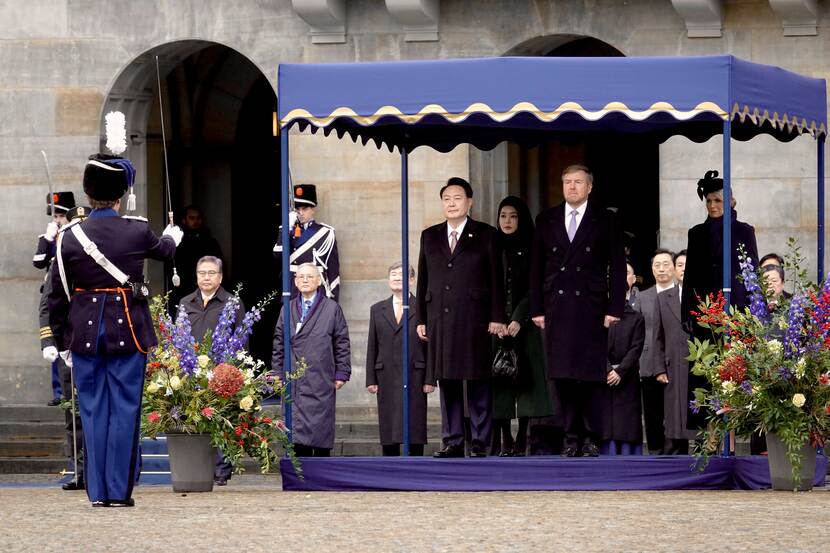
Wednesday 13 December
Visit to the states general .
On Wednesday morning, President Yoon will visit the Dutch Parliament in The Hague. There he will meet the president of the Senate, Jan Anthonie Bruijn, and the acting president of the House of Representatives.
Government lunch
At the Binnenhof, the president will be received by Prime Minister Mark Rutte, where they will discuss various matters concerning the strategic partnership between the countries, including economic security and stability in the Indo-Pacific region. After various MoUs have been signed, a government lunch will be held, attended by the King.
Meeting with veterans
Back at the Royal Palace in Amsterdam, the King and President Yoon will meet with Dutch veterans of the Korean War. During the meeting they will reflect on the history of the bilateral relations between the Netherlands and the Republic of Korea.
Business Forum
During the Business Forum, a CEO roundtable will be jointly hosted by the Confederation of Netherlands Industry and Employers (VNO-NCW) and the Korea International Trade Association (KITA). Another session will focus on ‘partnership through innovation’, with a view to linking sectors such as high-tech, the energy transition and agriculture and horticulture. Various MOUs between companies and the authorities will also be signed. The Minister for Foreign Trade and Development Cooperation will be present throughout the Business Forum. The King and President Yoon will attend the Forum’s closing session, where President Yoon will give a speech.
Korean music and dance event hosted by the president and his wife
In the evening, President Yoon and his wife will host a special event for the King and Queen: a classical Korean music and dance performance at AFAS Live in Amsterdam. After the King and Queen have taken their leave of the president and his wife, the state visit will come to a close.
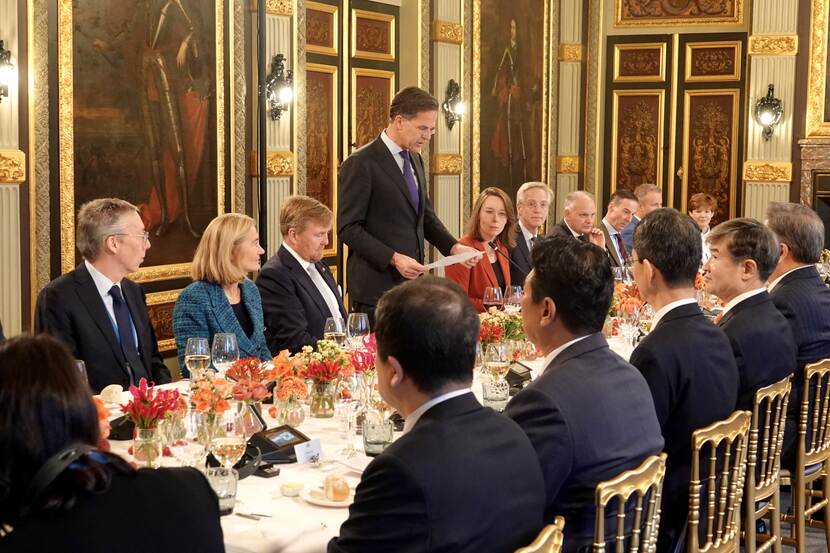
Government Information Service no. 316
Speech by King Willem-Alexander at the state banquet on the occasion of the state visit by President Yoon Suk Yeol of the Republic of Korea, Royal Palace, Amsterdam
Speech | 12-12-2023
Share this page
- Share this page on your Twitter account
- Share this page on your Facebook account
- Share this page on your LinkedIn account
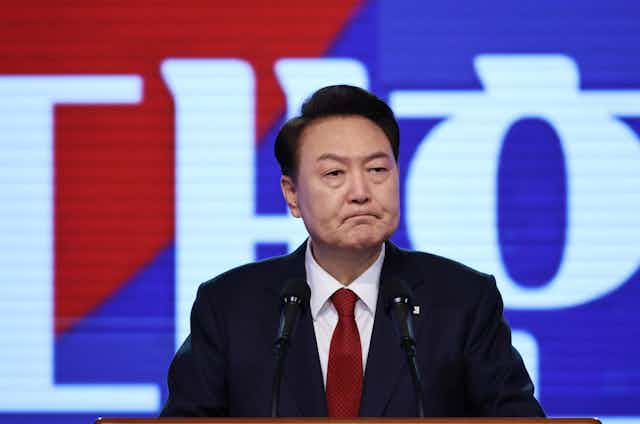
South Korean President Yoon faces foreign policy challenges after the National Assembly election
Assistant Professor, North Greenville University
Disclosure statement
Jong Eun Lee does not work for, consult, own shares in or receive funding from any company or organisation that would benefit from this article, and has disclosed no relevant affiliations beyond their academic appointment.
View all partners
South Korea’s parliamentary election of April 10, 2024, was widely seen as a referendum on President Yoon Suk Yeol’s first two years in office.
That being the case, the nation collectively expressed its strong disapproval.
With a relatively high turnout of 67%, voters handed Yoon’s conservative People’s Power Party defeat, with its share of the 300-seat National Assembly dropping from 114 to 108 .
The opposition Democratic Party retained its large majority in the National Assembly, winning 175 seats and maintaining control in the populous metropolitan areas of Seoul, Incheon and Gyeonggi provinces. Voters also delivered a disappointing outcome for most third-party candidates, the exceptions being the Rebuilding Korea Party , which campaigned as more combative opposition to the DP, and the New Reform Party , which broke away from the ruling PPP earlier this year.
As a political scientist with a focus on East Asia and international affairs , I believe the election results will have ramifications on Yoon’s foreign and domestic agenda during the remainder of his term.
Growing domestic pressure
Yoon had hoped the election would end the political gridlock that has stymied his first two years as president.
Throughout that time, the opposition has held a legislative majority . Subsequently, Yoon’s government has seen key parts of its agenda for education, labor and pension reforms blocked. Yoon has also vetoed multiple bills passed by the opposition-controlled legislature.
But the election saw the DP and other opposition parties amass 192 seats, just short of a veto-proof, two-thirds majority. As such, President Yoon again faces a divided government for the remainder of his term. In fact, he will be the only South Korean president whose party has failed to control the National Assembly at any time during the five-year presidential term.
A better parliamentary outcome for Yoon’s party would have bolstered the chances for the government’s legislative agenda on pressing domestic issues, such as addressing the country’s declining birthrate , high inflation and expanding medical student enrollment , as well as relaxing business regulations .
Instead, the Yoon government is more likely to be on the defensive after the election. Opposition parties have vowed to investigate alleged stock manipulation involving first lady Kim Keon Hee and probe former Defense Minister Lee Jong-sup over claims that he influenced an earlier report into the drowning death of a Korean marine .
Though Yoon retains veto power, there is now growing uncertainty over whether ruling PPP assembly members will continue defending the president’s actions if and when the two probes move forward.
Meanwhile, President Yoon’s prime minister, Han Duck-soo, announced his resignation after the assembly election. The National Assembly can vote against the president’s nominee to replace him, which may compel Yoon to pick a candidate acceptable to the opposition parties.
A trickier foreign policy climate
Under South Korea’s political system, the presidency has greater leeway in national security and foreign affairs than in domestic policy.
As such, the Yoon government will likely continue its foreign policy of expanding trilateral partnerships with the U.S. and Japan, building ties with NATO and striving to be a “ global pivotal” state in the Asia-Pacific region.
During his first two years in power, Yoon has generally aligned South Korea closer to the West, though he has also been careful to avoid direct confrontation with China and Russia – both of which are geographic neighbors and trade partners.
While the opposition-controlled National Assembly has, to date, been generally supportive of the Yoon government’s attempts to strengthen ties with the U.S. – a policy that remains popular among the South Korean public – the same cannot be said about its attempts to bolster relations with Japan.
In particular, the Democratic Party and the Rebuilding Korea Party have criticized the prospect of a closer partnership with Japan – whether through military exercises or intelligence sharing – mainly due to Korea’s experiences under Japanese colonial rule.
And despite being generally welcoming of ties with the West, the two opposition parties are more cautious than the Yoon government when it comes to engaging in geopolitical rivalry. Specifically, Democratic Party leader Lee Jae-myung warned during the recent election campaign that South Korea should not become involved in the Russia-Ukraine war or China-Taiwan tensions.
The opposition might not directly stop Yoon from pursuing his foreign policy, but they are likely to pressure the president to pay attention to domestic political issues.
Moreover, opposition parties will be pushing the Yoon government to demonstrate what diplomatic “wins” the country has secured through its partnership with Japan and the United States. Notably, if the point of strategic partnership with the United States and Japan is to ensure security in East Asia, some voters may legitimately ask why it has failed to deter North Korea’s continued military provocations .
If the Yoon government cannot demonstrate diplomatic successes, opposition parties are likely to frame his foreign policy as one-sided “ subservient diplomacy .”
Yoon has three years to show that his foreign policy has paid dividends; South Korea’s next presidential election is in the spring of 2027.
How successfully the president can navigate the domestic and international constraints exacerbated by the results of the parliamentary election could determine whether he exceeds the political expectations of a president facing a divided government or encounter, as some predict , an early “lame-duck presidency.”
- North Korea
- South Korea
- South Korea politics
- Yoon Suk-yeol

Program Manager, Teaching & Learning Initiatives

Lecturer/Senior Lecturer, Earth System Science (School of Science)

Sydney Horizon Educators (Identified)

Deputy Social Media Producer

Associate Professor, Occupational Therapy

Yoon touts S. Korea's 'global pivotal state' initiative as key foreign policy
Yoon-diplomatic missions
SEOUL, April 22 (Yonhap) -- President Yoon Suk Yeol highlighted Monday that the government's push to expand South Korea's diplomacy as a responsible "global pivotal state" has become a key part of his foreign policy.
Yoon made the remark during an annual meeting of the chiefs of the country's diplomatic missions, calling on the diplomats stationed overseas to continue their efforts in the foreign service, with a focus on diplomacy related to the economy and livelihoods.
"The global pivotal state diplomacy that we have put into practice since the launch of this government has become the government's signature policy," Yoon said during a banquet dinner he hosted for the mission chiefs.
The conference of the overseas diplomatic mission chiefs began earlier in the day for a five-day run. More than 180 ambassadors, consuls general and other heads of diplomatic missions in foreign countries are participating in the gathering.
The "global pivotal state" vision calls for South Korea to act as a responsible country that fulfills its international role and responsibility to help promote freedom, human rights and the rule of law.
Yoon also stressed the importance of the role of the diplomatic mission chiefs at a time when South Korea is facing multiple complex challenges.
"The role of the diplomatic mission chiefs is vital to South Korea in taking a new leap forward amid an unprecedented global polycrisis," Yoon said.
Yoon also asked the diplomats to strive to do their parts in protecting and providing support to North Korean defectors in other countries, casting the issue as the government's focus in its North Korea policy.
Some 220 participants attended Monday's event, including ministers and some ruling party lawmakers.
The ambassador post for Australia remains vacant, as the former envoy, Lee Jong-sup, resigned from the position less than a month after he was appointed, over allegations related to his time as the defense minister.

King Charles and Queen Camilla to Host Japan State Visit in June
Emperor Naruhito and Empress Masako's planned state visit to the UK in spring 2020 was postponed due to the pandemic.
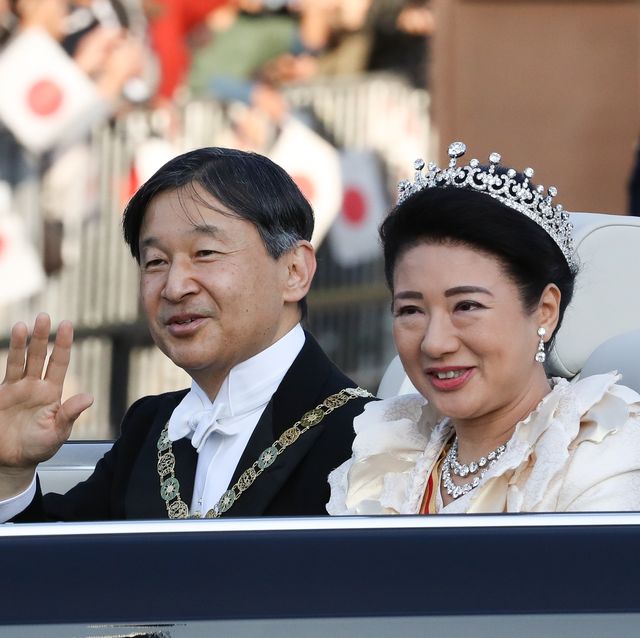
"Their Majesties The Emperor and Empress of Japan have accepted an invitation from His Majesty The King to pay a State Visit to the United Kingdom in late June 2024," Buckingham Palace today, sharing that King Charles and Queen Camilla will host the visit.
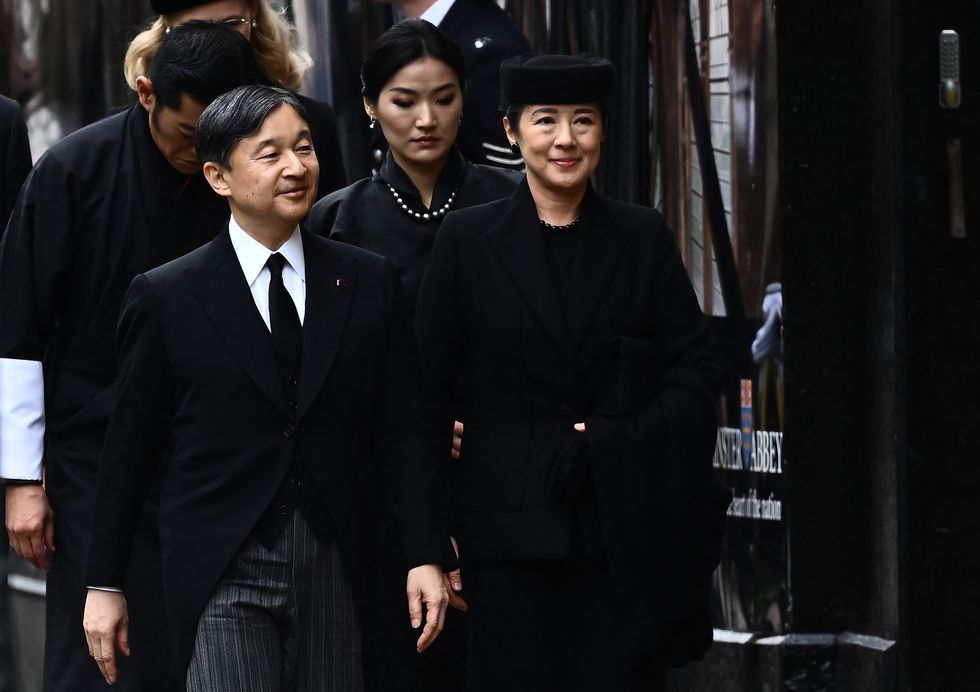
Emperor Naruhito and Empress Masako attended the state funeral of Queen Elizabeth in September 2022 , their first overseas trip since Naruhito's enthronement ceremony in 2019. They did not attend Charles and Camilla's coronation; instead, Crown Prince Akishino and Crown Princess Kiko attended on their behalf .
King Charles has a long history with the Japanese Imperial Family ; he's visited the country five times—the most recent trip occuring in October 2019, for the enthronement ceremony . This will be the third state visit he's hosted during his reign; the first, in honor of South Africa's President Ramaphosa , took place in November 2022, and the second, in honor of South Korea's President Yoon Suk Yeol , was in November 2023.
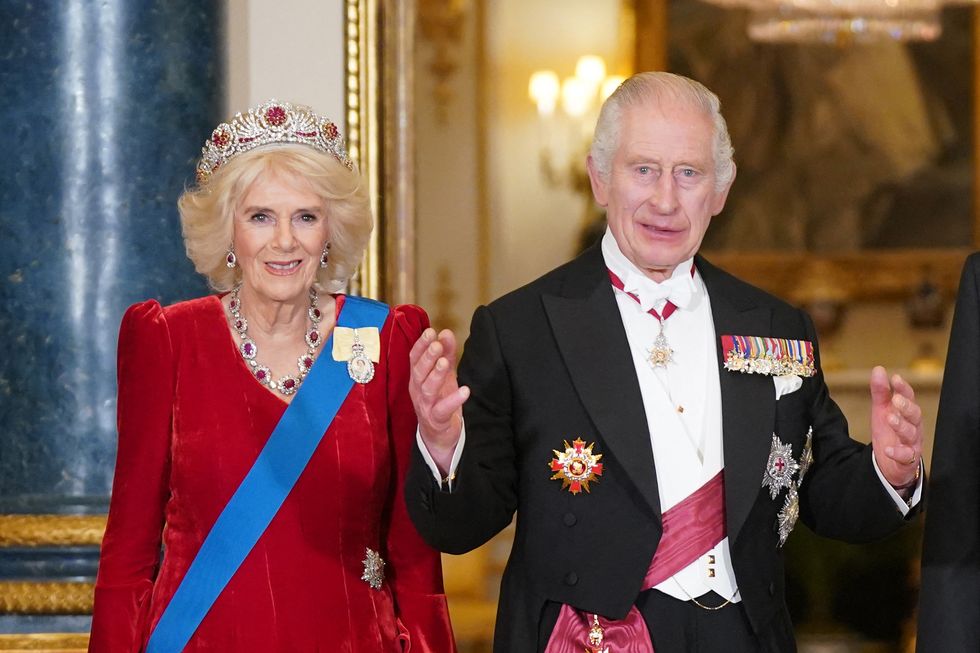
State visits typically include a state dinner on the first night, attended by senior members of the royal family. Per the royal family's website, the state banquet "is a very grand formal occasion held in the Buckingham Palace Ballroom. Around 150 guests are usually invited on the basis of their cultural, diplomatic or economic links to the country being hosted." (For example, South Korean girl band Blackpink attended the last state banquet. ) Typically, the royal women wear tiaras—at the last state banquet, Kate Middleton debuted the Strathmore Rose tiara and Queen Camilla wore the Burmese Ruby Tiara .
No specific date for the Japan state visit has been set yet, but we'll update this as soon as we learn more.
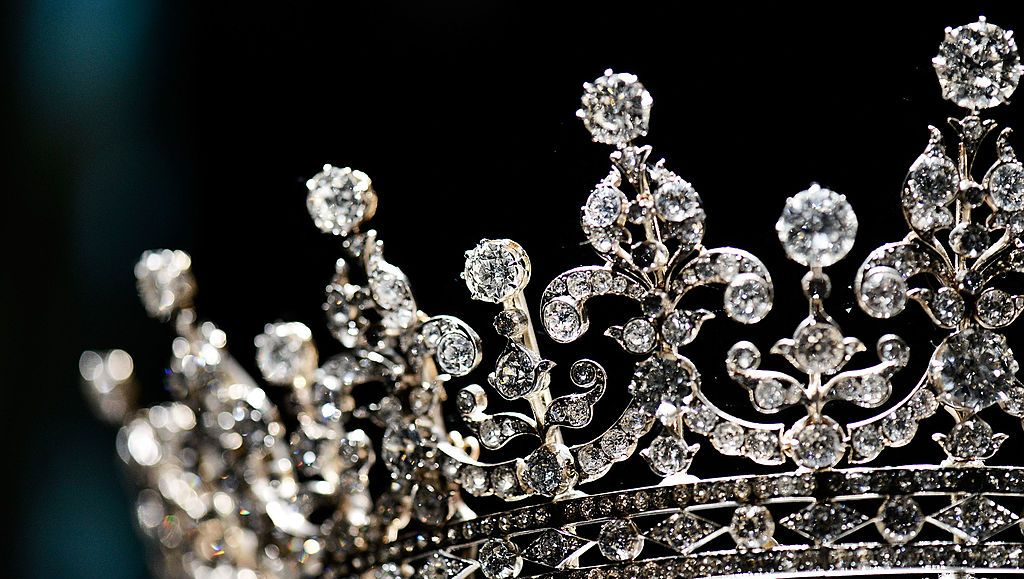
Emily Burack (she/her) is the Senior News Editor for Town & Country, where she covers entertainment, culture, the royals, and a range of other subjects. Before joining T&C, she was the deputy managing editor at Hey Alma , a Jewish culture site. Follow her @emburack on Twitter and Instagram .
@media(min-width: 40.625rem){.css-1jdielu:before{margin:0.625rem 0.625rem 0;width:3.5rem;-webkit-filter:invert(17%) sepia(72%) saturate(710%) hue-rotate(181deg) brightness(97%) contrast(97%);filter:invert(17%) sepia(72%) saturate(710%) hue-rotate(181deg) brightness(97%) contrast(97%);height:1.5rem;content:'';display:inline-block;-webkit-transform:scale(-1, 1);-moz-transform:scale(-1, 1);-ms-transform:scale(-1, 1);transform:scale(-1, 1);background-repeat:no-repeat;}.loaded .css-1jdielu:before{background-image:url(/_assets/design-tokens/townandcountrymag/static/images/diamond-header-design-element.80fb60e.svg);}}@media(min-width: 64rem){.css-1jdielu:before{margin:0 0.625rem 0.25rem;}} Royal Family News @media(min-width: 40.625rem){.css-128xfoy:before{margin:0.625rem 0.625rem 0;width:3.5rem;-webkit-filter:invert(17%) sepia(72%) saturate(710%) hue-rotate(181deg) brightness(97%) contrast(97%);filter:invert(17%) sepia(72%) saturate(710%) hue-rotate(181deg) brightness(97%) contrast(97%);height:1.5rem;content:'';display:inline-block;background-repeat:no-repeat;}.loaded .css-128xfoy:before{background-image:url(/_assets/design-tokens/townandcountrymag/static/images/diamond-header-design-element.80fb60e.svg);}}@media(min-width: 64rem){.css-128xfoy:before{margin:0 0.625rem 0.25rem;}}
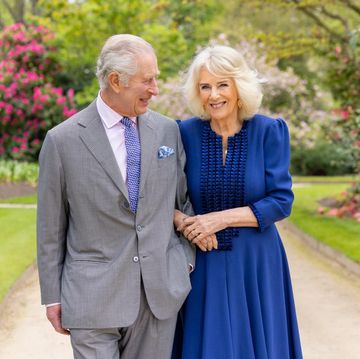
Charles Is "Recovering So Well," Says Photographer
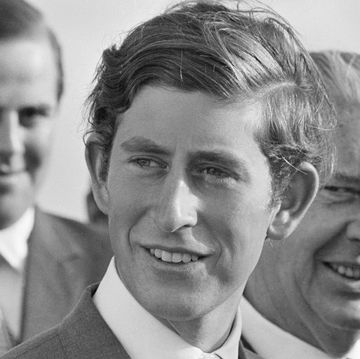
King Charles III's Life in Photos
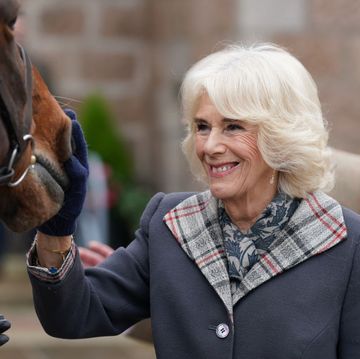
Queen Camilla's Life in Photos

The Most Memorable Royal Photos of 2024 (So Far)
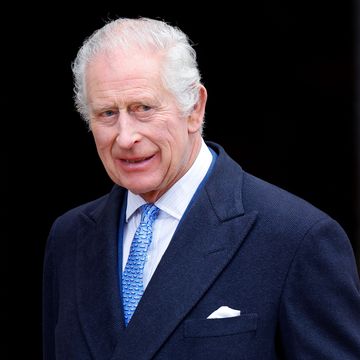
King Charles Cancer Diagnosis & Treatment Timeline
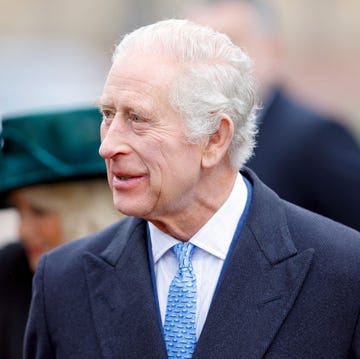
Buckingham Palace Shares an Update on King Charles
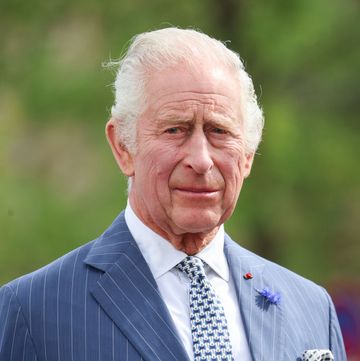
Charles's Doctors "Remain Positive"
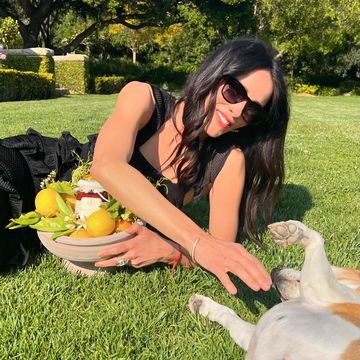
Who Received American Riviera Orchard Jam?
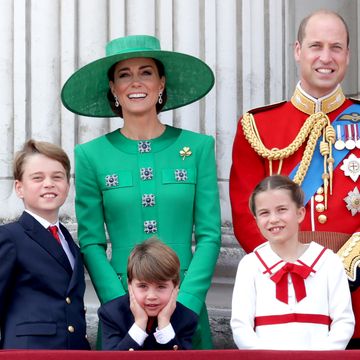
Prince William Shares Details of Family Pets
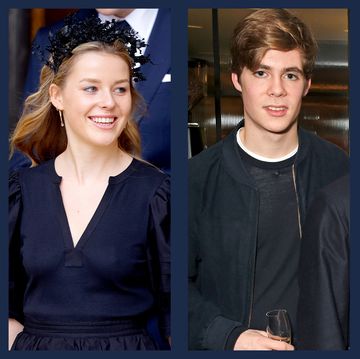
Princess Margaret's Grandchildren
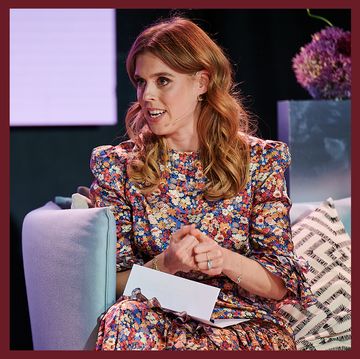
Princess Beatrice Wears Florals for Spring
- FOREIGN POLICY
- DOMESTIC POLICY
- World World Into section →
- Oil & gas industry
- Internet & Telecom
- Trade & Cooperation
- Military & Defense Military & Defense Into section →
- Science & Space Science & Space Into section →
- Emergencies Emergencies Into section →
- Society & Culture Society & Culture Into section →
- Press Review Press Review Into section →
- Sports Sports Into section →
- Special projects
- NEWS TERMINAL
- Personal data processing policy TASS
- Press Releases
- Privacy Policy tass.com
- Terms of use
- ANTI-Corruption
- Advertising
Seoul, Moscow discuss details of Putin’s visit to South Korea — ambassador
MOSCOW, November 27. /TASS/. Seoul and Moscow are coordinating the details of Russian President Vladimir Putin’s visit to South Korea, South Korean Ambassador to Russia Woo Yoon Keun has told TASS.
"President Putin has agreed several times to visit our country next year. We are in talks on the schedule for his visit to [South] Korea," the diplomat said.
According to the ambassador, Seoul assigns high priority to such contacts. "We are glad that President Moon Jae-in and President Putin meet every year. We try to make sure that these regular meetings continue," he stressed. "We attach great importance to these meetings."

Salient Issues in Ukraine-Russia Relations and Yanukovych’s Moscow Visit
Publication: eurasia daily monitor volume: 7 issue: 47, by: vladimir socor.
March 10, 2010 10:34 PM Age: 14 years
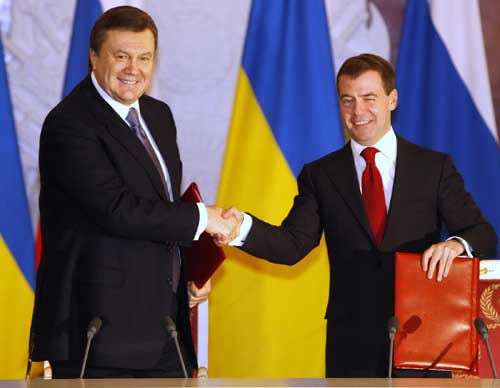
Ukrainian President Viktor Yanukovych’s visit to Moscow on March 5 (see “Yanukovych in Moscow: More Than Balancing the Brussels Visit,” EDM, March 10) focused almost entirely on bilateral relations, practically overlooking or avoiding international issues. The following issues were discussed in public:
• Governance model: Yanukovych praised Moscow’s handling of the financial-economic crisis as a worthy example for Ukraine to follow. Political stability has helped Russia to cope better than Ukraine did with the crisis, he observed. “My task is now to catch up with Russia, bring our living standards, pensions and social assistance up to Russian levels,” the gaffe-prone Yanukovych pledged. Sarcastically he offered to send some Ukrainian “demagogues” (politikany, politikanstvo) to Russia, so that the Russian people could even better appreciate the stability they enjoy. When Yanukovych said at one point that he must await the formation of a new coalition, Medvedev retorted: “I do not need to form a coalition to resolve any problems” (BBC Monitoring, March 9).
According to the Levada Center’s latest surveys of Russian public opinion, only 8 percent believe that Ukraine is more democratic than Russia. Conversely, between 50 percent to 65 percent believe that Russia is more democratic than Ukraine and feel compassion for the country because it must live with uncertainty about election results (Vedomosti, March 9). Such findings spell the end of Western assumptions, and Moscow’s fears, that the Orange Revolution might have provided a democratic example to Russia.
• Language Policy: Responding to the Russian media’s leading questions, Yanukovych assured Moscow that he would keep his presidential campaign promise to implement the European Charter on Regional and Minority Languages. This will result in conferring official status to the Russian language (apparently on a par with Ukrainian) in many of Ukraine’s regions, particularly in the Party of Regions’ strongholds.
Following his return from Moscow, Yanukovych made an appearance at the shrine to Ukrainian national poet Taras Shevchenko, assuring Ukrainians that their language would alone retain the status of the state language on a country-wide basis, while Russian would receive official status in certain regions (Interfax, March 9). This will, however, not allay concerns about linguistic de-Ukrainization and re-Russification in Ukraine’s east and south, resulting from this measure. As a sop, Medvedev and Yanukovych have decided to hold a joint Taras Shevchenko Year in Ukraine and Russia.
• Russia-Ukraine Interstate Commission: created and co-chaired by Putin and Yushchenko while presidents, the commission has remained inactive. Some of the sub-commissions have met periodically, however, notably the one tasked to delimit the maritime border and discuss contentious issues related to the Russian Black Sea Fleet based on Ukraine’s territory. Both sides now intend to hold a full meeting of the Interstate Commission during the first half of this year in Kyiv, in connection with Medvedev’s planned visit there. Ahead of that event, the new Ukrainian government (if and when it is installed) will prepare an action plan for the commission’s consideration.
• Black Sea Fleet: Medvedev and Yanukovych agreed that bilateral consultations should continue as before, based on the 1997 agreements on the temporary stationing of the Black Sea Fleet on Ukrainian territory. Characterizing this as a very difficult and complicated problem, Yanukovych implied that it can ultimately be settled by the two presidents among themselves. At the news conference, he promised to help resolve the issue “in a way that would satisfy both Ukraine and Russia,” and even “very soon.” The first part of the answer merely echoes Yanukovych’s campaign rhetoric, when he suggested prolonging the basing agreement beyond the 2017 deadline. The “very soon,” however, is a disconcerting addendum, possibly presaging a quick deal to Ukraine’s detriment.
• NATO: Russian leaders had apparently hoped for an explicit Yanukovych statement that Ukraine will not seek NATO membership (Rossiyskaya Gazeta, March 9). At the press conference, a planted question attempted to goad Yanukovych into endorsing an anti-NATO referendum, signatures for which are currently being collected in Ukraine. Instead, Yanukovych merely declared that “Ukraine will develop its relations with NATO as a non-bloc state and in accordance with its national interests” (Interfax, March 5).
• Soviet Legacy Preservation: Medvedev and Yanukovych agreed to celebrate the Soviet “great patriotic war” together in Moscow on May 8, and to “synchronize” the celebrations on May 9 with Belarus President Alyaksandr Lukashenka on a tripartite basis. This configuration was the only hint at a post-Soviet “Eastern Slavic solidarity” during Yanukovych’s visit.
Yanukovych promised to revoke, before the May celebrations, the Hero of Ukraine titles that Yushchenko had awarded to Stepan Bandera and Roman Shukevych, the leaders of the Ukrainian Insurgent Army (UPA) during the 1940’s. One of the most tactless decisions of the Yushchenko presidency, the award has become an irritant in Ukrainian-Polish relations, given that the UPA had mainly targeted the Polish civilian population and Armija Krajowa units in 1941-44 (and Bandera was an anti-Polish fighter prior to the war). From 1944 onward, however, the UPA resisted against the Soviet authorities, an activity that Russian authorities today continue to regard as criminal, in Ukraine or anywhere.
• Natural Gas: Yanukovych announced on the visit’s eve that he would urgently raise the issues of Russian gas supplies and transit (Russia-24 TV, March 4), meaning price cuts for Russian gas supplies, in return for sharing control of Ukraine’s transit system with Gazprom in a consortium. The current price is said to be $305 per one thousand cubic meters, with Yanukovych seeking a reduction to $210 (Kommersant, March 5). Key industrialists behind Yanukovych and his Party of Regions need discounted gas to maintain their competitive position internationally. The party itself would promise cheap gas to the populace, if snap parliamentary elections are held in Ukraine this year, as seems distinctly possible. Gazprom control of Ukraine’s transit system would be the price for cheap gas.
Ironically, Yanukovych accused the outgoing Prime Minister Yulia Tymoshenko of “destroying the contractual basis” of the Russian-Ukrainian gas trade. However, it was Putin who signed the contract with Tymoshenko in January 2009, and Moscow declares itself satisfied with its commercial terms to this day. According to Russian Energy Minister, Sergei Shmatko, after the talks, the gas price and gas transport consortium have not been discussed with Yanukovych. Moscow will discuss this issue after the formation of a new Ukrainian government, and as part of preparations for Medvedev’s planned visit to Kyiv in the first half of the year (RIA Novosti, March 6).
• Steel: Yanukovych solicited lower tariff barriers and higher quantitative quotas for Russian imports of Ukrainian steel products (Interfax, March 7). This remains a contentious issue in bilateral relations at the state level from the mid-1990’s to date. Former president Leonid Kuchma and his governments (including Yanukovych’s) perennially raised this grievance with their Russian counterparts. Leading Ukrainian steel producers expanded into European markets in recent years, reducing their interests in ties with Russia. The economic crisis, however, has increased again the importance of the Russian market to the Donetsk steel industry. It seeks not only to return there but also to bid for contracts to supply steel pipes for Russia’s Nord Stream and South Stream pipeline projects.
• Customs Union: Russian leaders had expected Yanukovych to consent, at least in principle, to join the Russia-Belarus-Kazakhstan Customs Union and, in a follow-up stage, the Single Economic Space planned by those countries (Rossiyskaya Gazeta, March 9). Yanukovych demurred twice, citing Ukraine’s membership in the World Trade Organization (WTO) as its overriding choice. This must have irritated the Russian leaders. When Yanukovych spoke afterward of a “complete turnaround in Ukrainian-Russian relations,” Putin retorted curtly: “Then join the Customs Union” (Interfax, March 5, 7).
That remark displays Moscow’s approach to the Customs Union as a Russian-owned project, participation in it being a function of each country’s bilateral relations with Russia. The relevant paragraph in the joint concluding declaration, however, reads: “Respecting the freedom of choice, mechanisms and forms of the countries’ participation in economic integration processes, Russia and Ukraine will strive to ensure that this participation does not harm the interests of their bilateral cooperation.” Thus, Moscow desists, at least for now, from asking Ukraine to choose between the WTO and the Russian-led Customs Union.
• Agriculture: A cryptic remark by Yanukovych in Moscow seemed to allude to a Russian-Ukrainian grain cartel. This idea has tentatively been broached earlier, but was not developed. Yanukovych said in Moscow that Ukraine, always a great breadbasket, “must use the huge potential of our agricultural sector” together with Russia. He suggested that “joint actions in the grain market” be included in the action plan, which is to be prepared for the meeting of the Russia-Ukraine Inter-governmental Commission in the first half of this year (Interfax, March 5).
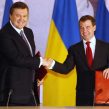
Marc Chagall and Jewish Theater, Part Two
by Jeanne Willette | Nov 18, 2016 | Modern , Modern Art
Marc Chagall in Moscow
The murals for the jewish theater, part two.
Perhaps because he was the first to visually imagine a totally Yiddish world, mystical and magical, sophisticated and folkish, avant-garde and traditional, Marc Chagall’s ability to capture the modernity of a new Jewish identity left a mark on Yiddish theater in Moscow. The Moscow State Yiddish Theatre ( Moskver idisher melukhisher teater ) also known as GOSET became a staging ground for the incorporation of Yiddish culture into mainstream Russian society. Chagall was “present at the creation,” as it were and his unique and distinctive vocabulary and his iconic imagery made a powerful impression upon both artists who had to follow in his wake and upon delighted audiences. Abram Efros, the art critic, wrote in 1922 of the extraordinary experience of viewing the collaboration between Alexi Granovsky and Marc Chagall,
Oh, that Yiddish theater!–without a foundation or a roof, without borers to its domain or any blueprint! A theater that is its own grandfather, father and son. A theater that has not yet any past, present, of future, and that must create for itself a past, a present, and a future. A theater that has to live simultaneously in three dimensions of time. A theater with no tradition, but which has to invent for itself a historical time line; a theater without a present, but which has to be at the cutting edge of contemporary theater art; a theater without perspective, but which has to old the form of what is to come.
A sponsor and supporter of Marc Chagall, Efros was one of the first to write of the excitement of presenting Yiddish culture after the new Soviet Union, under Lenin withdrew from the Great War. Suddenly all restrictions on Jewish movement and upon Jewish cultural expressions were withdrawn and opportunities presented themselves to artists like Chagall who now had the possibility of creating the foundational visuals of Yiddish culture. The artist, fresh from his humiliation in Vitebsk, rallied and produced a series of murals, which turned a confiscated home into an enveloping work of art, a backdrop against which the beloved stories of Sholom-Aleihem were performed. Efros noted that the State Yiddish Chamber Theater both benefited and paid for the success of Chagall, who proved to be a hard act to follow. The critic wrote that the artist “did not..accept any directions..” and that Chagall “forced us to pay the most expensive price for the Jewish national form of scenic expression..in the end, the young Yiddish theater struggled because of this victory.” In 2009, Mel Gordon , professor of theater arts at Berkeley, noted that the Moscow Yiddish State Theater was the most successful theater of its time, even though the majority of the audiences did not understand Yiddish. Gordon pointed out that although Chagall mounted only one production in 1921 at the GOSET, he marked the theater with “Chagallism,” the “touch that utterly changed” the theater group and “created a new art form.”
Gordon revealed that Granovsky–a child of a wealthy family–did not speak Yiddish, which was “lower class” or vernacular, and had no interest in Yiddish culture, but he found himself in Russia after the Revolution, a nation that no longer spoke the enemy language of German. Nevertheless the director wrote of the new theater in a brochure: “Yiddish theater is first of all a theater in general, a temple of shining art and joyous creation — a temple where the prayer is chanted in the Yiddish language.” Many Jews who came to Moscow were Russian speakers but were eager to support their own culture and didn’t seem to mind if they couldn’t understand Yiddish. This simple fact encouraged Granovsky to create the kind of theater that depended upon visuals rather than upon dialogue, making of the Yiddish theater a optical spectacle that allowed the viewers to follow the stories thought gestures and postures which provided plot and action without words. The best way to explain this new form of acting, or “spots,” is to compare the plays to the fragmentation of Analytic Cubism.
Sadly, Granovsky and Chagall were unable to see eye to eye. The conflict was unsurprising, given that Chagall had a deep understanding of Yiddish culture and Granovsky was expecting an “origin story” of Yiddish culture which existed on a higher plane. Chagall understood that Yiddish culture was a distinct folk culture, cut off from elite culture, and knew first hand that the Jewish culture was down to earth and even vulgar and obscene and offensive. In comparison to urban Jews throughout Europe, the Russian Jews, unless they were wealthy and privileged, were unassimilated and alienated. Therefore, it could be concluded that the Yiddish culture was “authentic” and unalloyed by outside influences. Chagall’s vision of ghetto and shtetl popular culture as evolved by a peasant culture of lower class people was seriously at odds with Granovsky, who had higher ambitions, derived from his apprenticeship with Max Reinhardt, and expected perhaps an idealized and sanitized rendition of what an outsider would have preferred “Yiddish” to be–not quite so alien and ungoverned.
As autobiographical as always, Chagall depicted himself and his family and the relatives who lived in Vitebsk and Lion and wrote the names of his numerous relatives into patterns on the trousers of a clown who played a flute. The frieze above the windows portrays a wedding, a highlight of Yiddish culture, a guarantee that the Jewish people will continue as a unique group. The wedding was a continuous feast, an endless celebration symbolized by food, paschal hala and New Year’s dishes. Below the entirety of a Jewish year, are a series of four personifications of Yiddish culture, set between the back windows. These narrow spaces were inhabited with the klezmer or the musician and the badchan or wedding jester and the svacha , a dancing woman, all of which appeared as allegories for creativity in the performing arts. The icon for Poetry was a sofier , or the scribe who copied the Torah in the peace of his private quarters.

A “bodkin” at a Jewish Wedding also known as “Drama”
By using these apparently stock figures in Yiddish culture, Chagall, the son of the shtetl, introduced a defiant authenticity into the theater with his use of “bodkins” or Jewish comedians whose humor was vulgar and homophobic and did not invite laughter. In addition, Chagall insisted that, contrary to Russian expectations, Jewish literature did not emerge from religious documents, but from folk tales or “grandmother’s tales,” oral tradition, as recreated by Sholom-Aleihem. Because he was revered and accepted by both Russian and Yiddish speakers, Sholom-Aleihem, who made the choice to write in Yiddish, was a wise choice for the first event of GOSET. According to the 1993 Guggenheim exhibition of the murals,
Through a natural outgrowth of his painterly vocabulary, Chagall presented a kaleidoscopic panoply of ecstatic figures in this work, which suggested an anti-rational model of carnivalesque abandon for the theater. This conceptualization of theater was not entirely new; Russian directors such as Vsevolod Meierkhol’d and Aleksandr Tairov were exploring the legacy of commedia dell’arte and other popular theatrical spectacles before Chagall began work on the murals.” Granovskii was already disposed to that kind of dramatic treatment through his studies under Max Reinhardt, the progressive Austrian director. Yet Chagall presented a unique, and uniquely Jewish, approach. Through specifically Jewish visual puns, Yiddish inscriptions, and references to the festivities of Jewish weddings and Purim — a Jewish analogue to carnival in its emphasis on ludicrous masquerades and outrageous intoxication — he posited a distinctive model for the Jewish Theater.
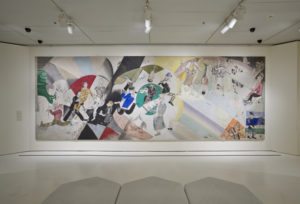
Marc Chagall. Introduction to Jewish Theater (1921)
In order to understand the “Chagall Box,” it is necessary to view the murals by the artists as both contrarian and as revelatory of a long hidden culture of lower class rural Jews. Appearing between the windows at the back of the theater as a rectangular “portrait,” the “bodkin,” according to Gordon, was a “sour” comedian who was featured at Jewish weddings with the task of overturning convention and even decency. The bodkin would make the bride and groom cry, if he was good at this job, that is, and he would direct his most cutting remarks to the wealthiest and most successor and most smug residents of the ghetto. In other words, the bodkin was a leveler and created a moment of the carnivalesque, when conventions were inverted. The charivari was a Medieval European custom which was a subversive upending of the expected norms. To this day, in some parts of Europe a charivari will disturb the wedding night of a bride and groom. This counter culture, the antithesis to elite courtly behavior, was vividly depicted by Chagall on his twenty-five foot mural, Introduction to Jewish Theater , where he deliberately conflated Yiddish culture with Yiddish theater with its source of origin, the irreverent bodkin, to the often scatalogical and male culture of urinating and farting.
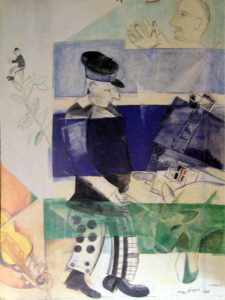
Detail of “Introduction to Jewish Theater”
The question is why did Chagall assert such a strong vision of Yiddish culture, unadorned and unadulterated, presented in a “popular manner” or folkstimlekh ? Why was he not more tactful and and cautious in his “Introduction?” The answer probably rests in the mood of the Jews in Russia after the Revolution. For the newly freed Jews, the insertion or absorption of Yiddish or Hebrew cultures of the “masses” into the fabric of Russian culture was part of the Revolution itself. In making Jewish life part of a pan-Russian society, intellectual and political Jews, like Marc Chagall, insisted on bringing society into a state of equality. Therefore, in Chagall’s murals, we can read an insistence of equivalency of high and low culture and a refusal to censor or subdue aspects of the shtetl. Indeed as Benjamin Harshav pointed out, the theater was guided by two leading principles: “theater as Art” and “theater of the State.” Therefore, the characters created by Sholom-Aleihem and Marc Chagall are tropes or character types, exaggerations of iconic figures well-know and well-honed over centuries, such as the hapless schlemiel .
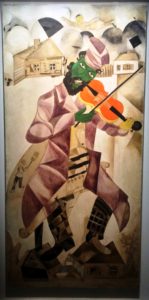
“Music” as personified by the Green Fiddler and “Literature”
In the book, Marc Chagall and His Times: A Documentary Narrative , by Benjamin Harshav and Barbara Harshav, it was pointed out that
The dense traditional culture of the Jewish religious world was now seen as folklore, a source of vitality, imagery, and folk wisdom that can be recycled into the modern, secular world, as Chagall tried to do in his murals for the Moscow Yiddish Theater. For a while, Chagall participated in this revival, he even restored his presumed original family name, and signed several paintings “Moyshe Segal.” The vast mural which “introduced” the origins of Jewish theater to the Moscow audience can be read from left to right–in Russian fashion–or from right to left—in Yiddish fashion, but in between is an antic display of dense imagery that needs to be read in terms of what the authors term “Jewish folk semiotics.” Quite different from the logic of Enlightenment thinking, this semiotic system reflects “a mind of associations that perceives events as situations and images parallel to one another in a global universe, rather than points in a causal chain, a narrative sequel with precise, rational chronologies. This traditional Jewish folk semiotics derives from the perception of post biblical Judaism, that after the destruction of the Jewish state and the close of the Bible, history was over; that their is a totality of beliefs above all and any history and geography; that the Jews are a chosen and persecuted nation irrespective of the changing powers and politics, and nothing changes until the Messiah comes..Most traditional Jewish texts lack a narrative direction (except for the short stories embedded in them); that is, every detail is not a link in a chain of events, but is significant outside of its context, in a total universe of meaning. Hence it needs interpretation rather than counting. And this atemporal world perception and significance of every detail was internalized in Jewish folklore and behavior. Detail from “Introduction to Jewish Theater,” featuring Chagall on the far left being carried in by Abram Efros.
Chagall did not stay to savor his brief triumph in the theater and left Russia in 1922 and did not return until 1973. Discouraged at the state of the art world, he wrote, “Neither imperial Russia nor the Russia of the Soviets needs me. They don’t understand me. I am a stranger to them. I am certain Rembrandt loves me.” Indeed Granovsky found that Chagall was trouble, “taking liberties,” and was unmanageable and was unable to comprehend the profound impact the murals would have upon theatrical production in Russia. Another designer, Nathan Altman was asked in 1922 to design sets and costumes for The Dybbuk , and Chagall was passed over. When he saw the performance, he felt that Altman had copied his conceptions from 1921 and translated them to a watered down version of his (postmodern avant la lettre ) view of the Jewish world. He wrote, “Those five years churn my soul. I have grown thin, I’m even hungry.” Thanks to Lunacharsky, his old friend, Chagall was given permission to leave the Soviet Union, ostensibly to deliver art works to Paris. He was forced to leave without his wife, Bella, and their only child, Ida, but they joined him later in 1922. In 1924 the murals were moved to a new site, a concert hall more suited for theatrical productions. During these years, avant-garde art and Jewish culture was gradually purged from the Soviet system by Stalin. Few of Chagall’s associates, friends or enemies colleagues survived the purges and censorship of the thirties and he alone of the Russian avant-garde left to paint in freedom in France.
The Wedding Feast Frieze (1920)
Tempera, gouache and white highlights on canvas, 64 by 799 cm. State Trtyakov Gallery
Through a miracle, Chagall’s murals were preserved in situ until they were hidden away in 1937 by an admirer, Alexander Tyshler. In the post-Stalin era, Tyshler turned the murals over to the Tretyakov Gallery in August of 1952 where they remained for the next twenty years. The artist had little hope that he would ever see the murals again and in fact, until 1973, this important body of work was unknown to the West. To Chagall’s joy, the seven murals, painted on the floor in goauche and tempera on canvas in forty days, had been removed from the walls and saved. The canvases were wrapped around drums which preserved the fragile painted surfaces. Chagall signed and dated the murals, interestingly enough in Russian, and from 1989 to 1990 they were restored at the Fondation Pierre Gianadda in Martigny, Switzerland and exhibited at the Guggenheim Museum in a landmark exhibition of 1992-1993.
If you have found this material useful, please give credit to
Dr. Jeanne S. M. Willette and Art History Unstuffed.
[email protected]
Recent Posts
- Art Deco and Women
- Le Corbusier: Purism as the Ideal City
- Le Corbusier: The Pavillon de l’Esprit Nouveau
- The Soviet Pavilion 1925
- Constructivism and the Avant-Garde

IMAGES
COMMENTS
President Biden of the United States welcomed President Yoon of the Republic of Korea (ROK) on April 26, 2023, for a State Visit to commemorate the 70th anniversary of the U.S.-ROK Alliance.
The President of the Republic of Korea, His Excellency Yoon Suk Yeol, accompanied by Mrs Kim Keon Hee, will pay a State Visit to the United Kingdom as the guest of His Majesty The King from 21st to 23rd November 2023. Their Majesties The King and Queen will host the State Visit at Buckingham Palace. State Visit programme. MONDAY 20th NOVEMBER
Biden welcomed Yoon to the White House for the full pomp and circumstance and hospitality of an official state visit - a high-stakes meeting amid ongoing provocations from North Korea, China's ...
Watch: President Biden's Tweet Highlighting the State Visit FACT SHEET: Republic of Korea State Visit to the United States. President Biden of the United States welcomed President Yoon of the Republic of Korea (ROK) on April 26, 2023, for a State Visit to commemorate the 70th anniversary of the U.S.-ROK Alliance.
President Biden of the United States welcomed President Yoon of the Republic of Korea (ROK) on April 26, 2023, for a State Visit to commemorate the 70th anniversary of the U.S.-ROK Alliance. ... This fact sheet provides an overview of political understandings that were affirmed or reaffirmed during the State Visit, as well as plans for further ...
WASHINGTON (AP) — President Joe Biden will crank up the pomp and pageantry for South Korea's president. The White House on Tuesday announced its second state visit, an April 26 affair for President Yoon Suk Yeol and his wife, Kim Keon Hee. The occasion, which will include a splashy black-tie dinner honoring Yoon, stands apart from other ...
WASHINGTON (AP) — South Korean President Yoon Suk Yeol opened his state visit to Washington on Tuesday by touring a NASA facility with Vice President Kamala Harris as the Biden administration looks to deepen ties with a close ally that it sees as only growing in importance in an increasingly complicated Indo-Pacific.. Before Harris and Yoon's visit to the Goddard Space Flight Center in ...
All right, good to be with you guys. As noted, this week President Biden will welcome President Yoon to the White House, his second official state visit, making - marking not only the first state visit by an Indo-Pacific leader during the Biden-Harris administration, but the 70th anniversary of the U.S.-ROK alliance.
President Joe Biden and First Lady Jill Biden will host President Yoon Suk Yeol and First Lady Kim Keon Hee of the Republic of Korea (ROK) for a State Visit to the United States, which will ...
Yoon's April 24-29 trip will be the first state visit to the United States by a South Korean leader since 2011 and will mark the 70th anniversary of the countries' alliance.
South Korean president Yoon Suk Yeol's U.S. state visit on April 26, the highest honor for a visiting head of state, resulted in some noteworthy deliverables, including the Washington Declaration and an expansion of the "New Frontiers" agenda of the relationship.
The last state visit to the United States by a Korean leader was 12 years ago by former President Lee Myung-bak in October 2011, upon the invitation of U.S. President Barack Obama. Yoon will become Biden's second state guest after French President Emmanuel Macron, who visited the White House last December.
President Yoon Suk Yeol and first lady Kim Keon-hee embarked on a weeklong state visit to the United States Monday in a trip that is expected to strengthen security and economic cooperation and celebrate 70 years of the Korea-U.S. alliance.
U.S. President Joe Biden will host his South Korean counterpart, Yoon Suk Yeol, for an official state visit on April 26. White House Press Secretary Karine Jean-Pierre told reporters Tuesday ...
'Ambitious and comprehensive' deals Yoon's state visit will be an opportunity for a set of comprehensive agreements and deals to be sealed between the two countries. During this visit, the two sides are also set to adopt a Korea-UK Accord, meant to detail the future direction of bilateral cooperation, as a testament to the upgraded relations.
The state visit was complicated by the leak of classified documents that included evidence the U.S. has been spying on allies. It was an embarrassment for the Biden administration and caused Yoon ...
The second state dinner of the Biden presidency was the social climax of Yoon's six-day visit to the states, timed to mark the 70th anniversary of the mutual defense treaty between South Korea ...
South Korean President Yoon Suk-yeol arrived in Washington on Monday for a week-long official visit. It marked the second state visit by a foreign leader to the US since President Joe Biden took ...
The President of the Republic of Korea and Mrs Kim Keon Hee were welcomed on Horse Guards Parade in London on the first day of their State Visit to the UK. The Prince and Princess of Wales greeted President Yoon Suk Yeol and the First Lady at their hotel, before travelling to Horse Guards. The President and the First Lady were formally welcomed ...
By Associated Press. |. April 25, 2023, at 5:13 p.m. Yoon Opens State Visit With Spotlight on Space, Mega Deals. More. Susan Walsh. Vice President Kamala Harris, right, walks with South Korea's ...
Published 26 September 2023. The President of the Republic of Korea, His Excellency Yoon Suk Yeol, accompanied by Mrs Kim Keon Hee, has accepted an invitation from His Majesty The King to pay a State Visit to the United Kingdom in November. The King and Queen will host the State Visit at Buckingham Palace.
This is the first state visit to the Netherlands by a president of the Republic of Korea since the two countries established diplomatic relations in 1961. In 2014 the King and Queen paid a state visit to the Republic of Korea. In November 2022, Prime Minister Mark Rutte and President Yoon concluded a Strategic Partnership Agreement.
Yoon has also vetoed multiple bills passed by the opposition-controlled legislature. But the election saw the DP and other opposition parties amass 192 seats, just short of a veto-proof, two ...
Yoon-diplomatic missions SEOUL, April 22 (Yonhap) -- President Yoon Suk Yeol highlighted Monday that the government's push to expand South Korea's diplomacy as a responsible "global pivotal state ...
Emperor Naruhito and Empress Masako's planned state visit to the UK in spring 2020 was postponed due to the pandemic. ... and the second, in honor of South Korea's President Yoon Suk Yeol, ...
MOSCOW, November 27. /TASS/. Seoul and Moscow are coordinating the details of Russian President Vladimir Putin's visit to South Korea, South Korean Ambassador to Russia Woo Yoon Keun has told ...
Ronald Reagan, Speech at Moscow State University. Digital History ID 1234. Author: Ronald W. Reagan. Date:1988. Annotation: During a visit to the Soviet Union in 1988, President Ronald Reagan, a lifelong anti-communist, met with students at Moscow State University and delivered a stirring plea for democracy and individual rights.
Ukrainian President Viktor Yanukovych's visit to Moscow on March 5 (see "Yanukovych in Moscow: More Than Balancing the Brussels Visit," EDM, March 10) focused almost entirely on bilateral relations, practically overlooking or avoiding international issues. The following issues were discussed in public: • Governance model: Yanukovych praised Moscow's handling of the financial-economic ...
Tempera, gouache and white highlights on canvas, 64 by 799 cm. State Trtyakov Gallery. Through a miracle, Chagall's murals were preserved in situ until they were hidden away in 1937 by an admirer, Alexander Tyshler. In the post-Stalin era, Tyshler turned the murals over to the Tretyakov Gallery in August of 1952 where they remained for the ...